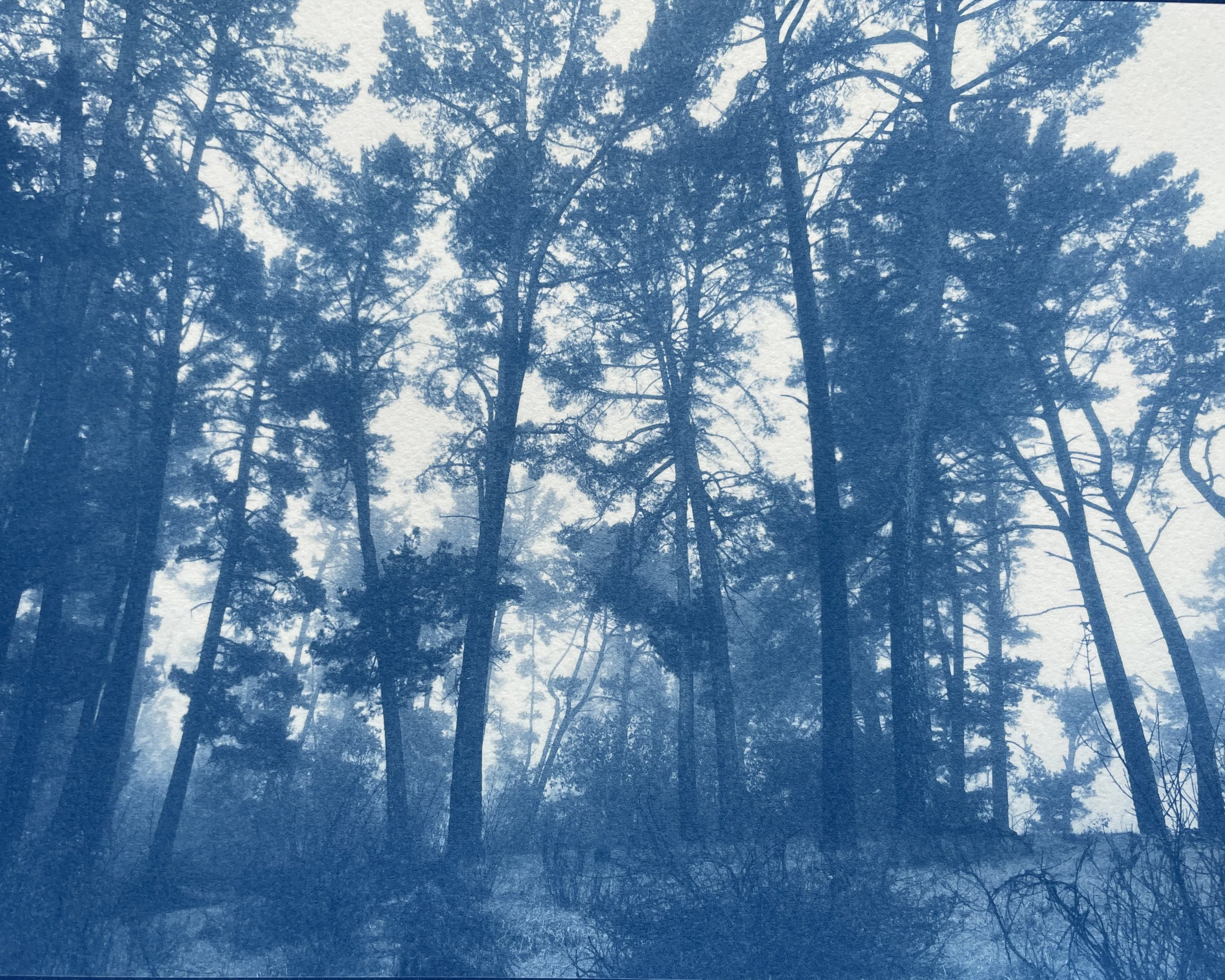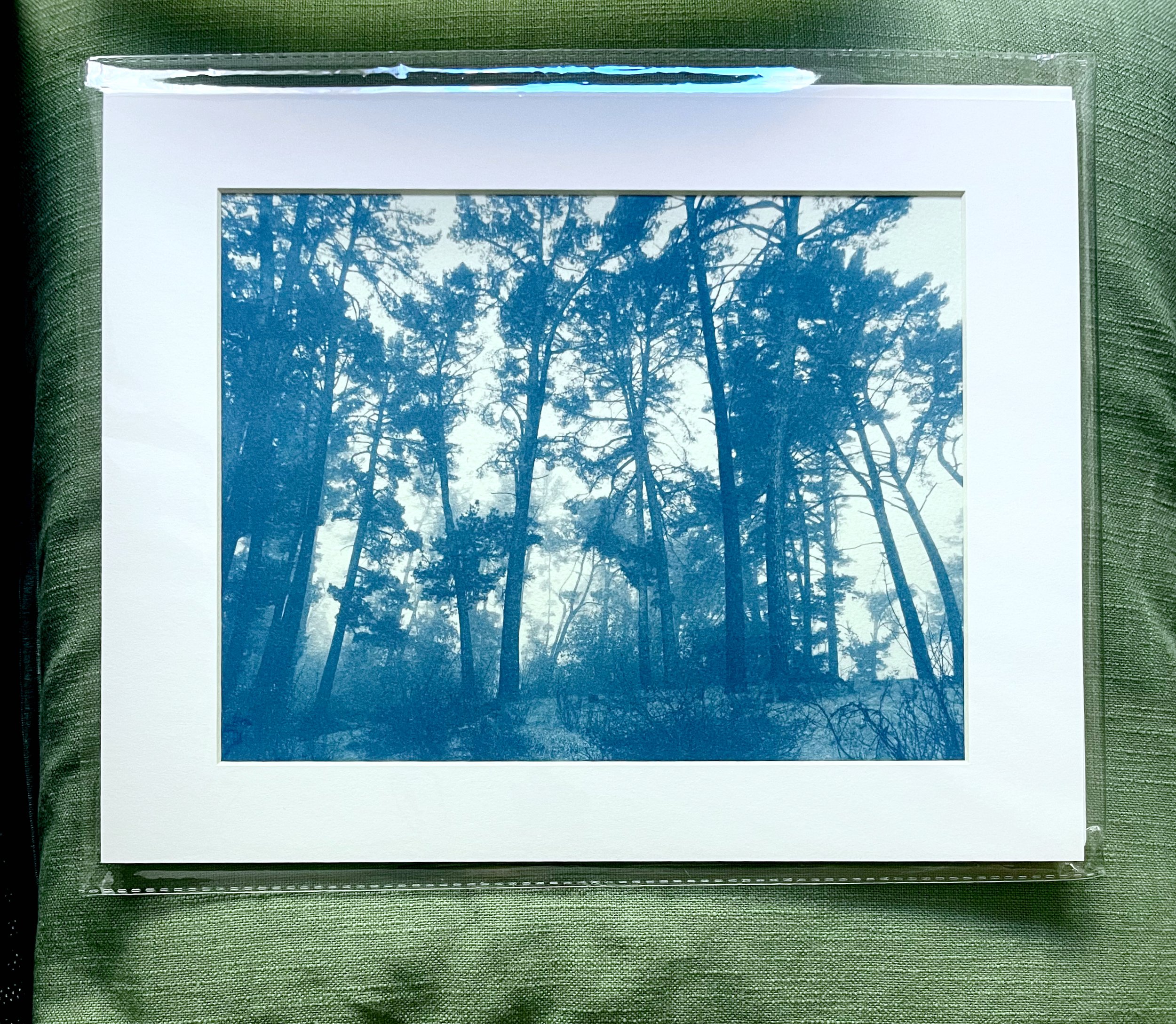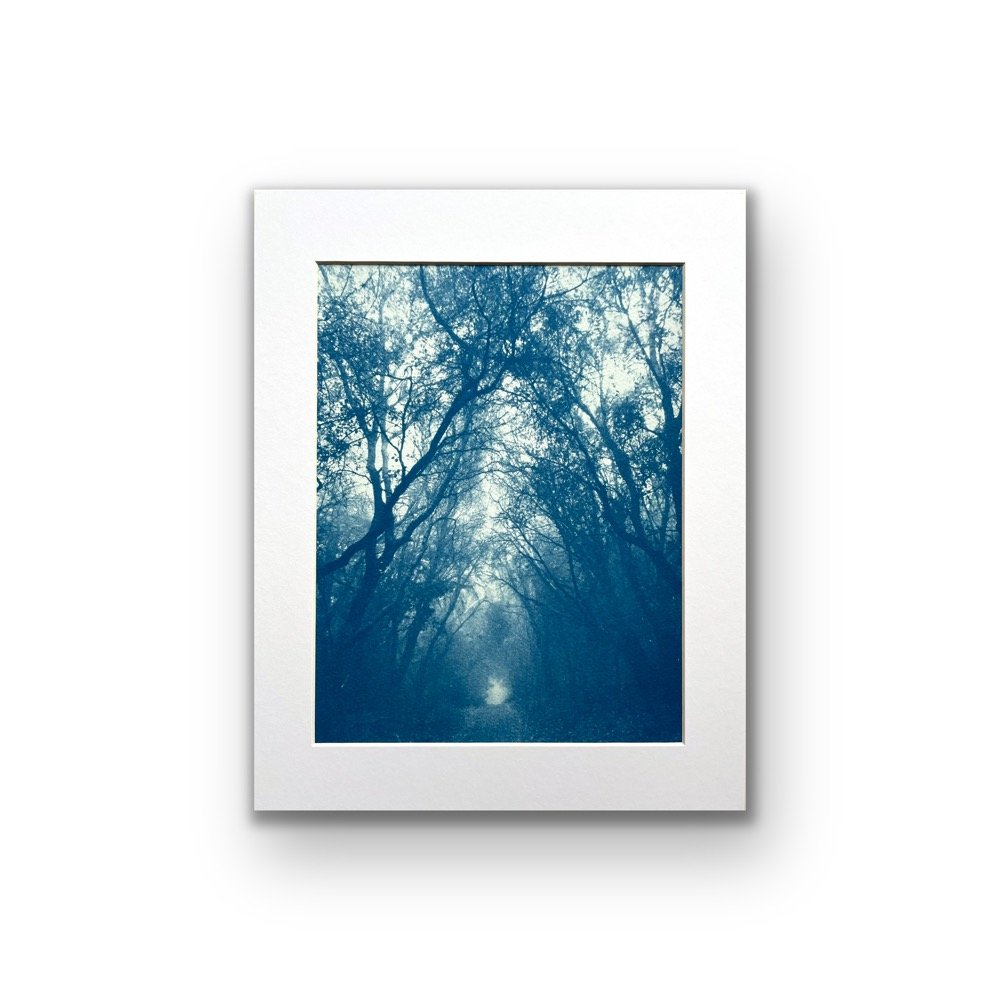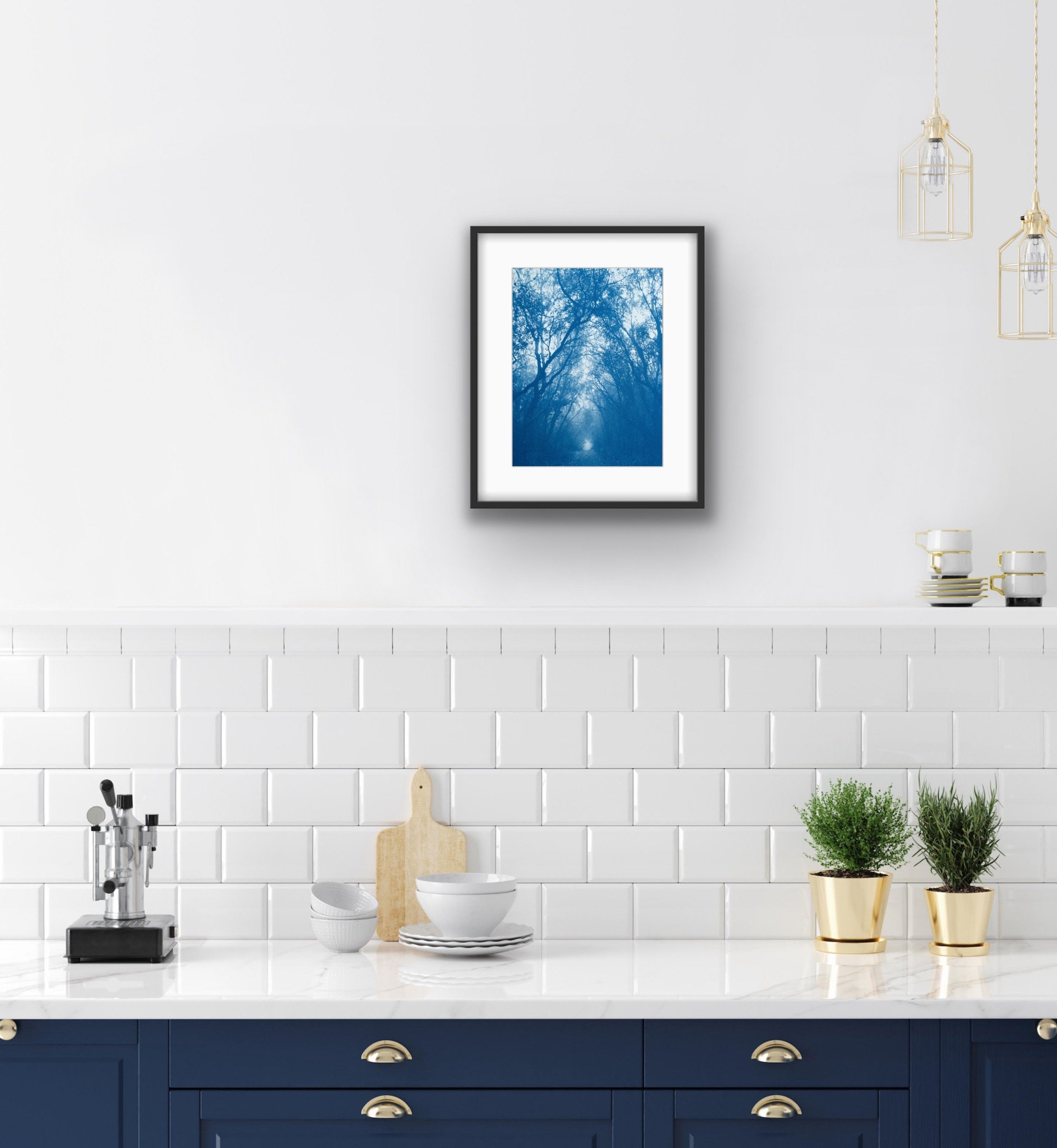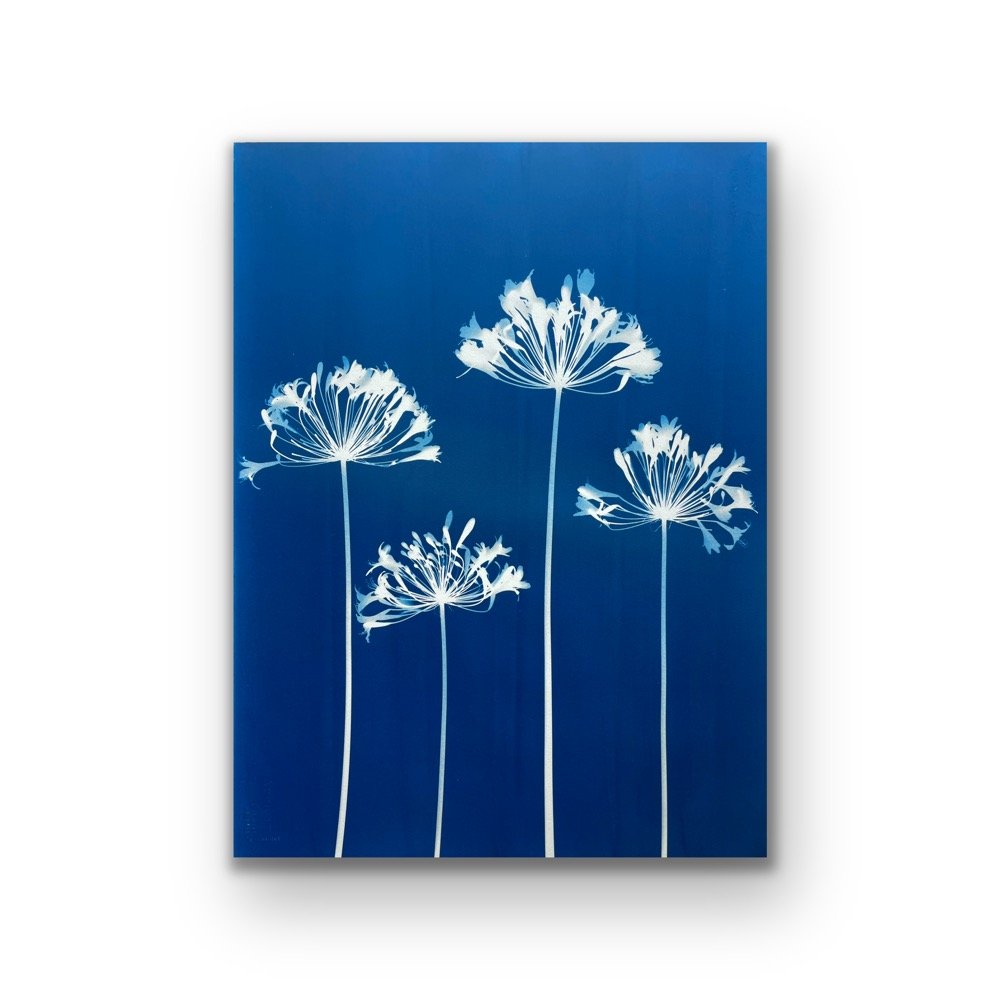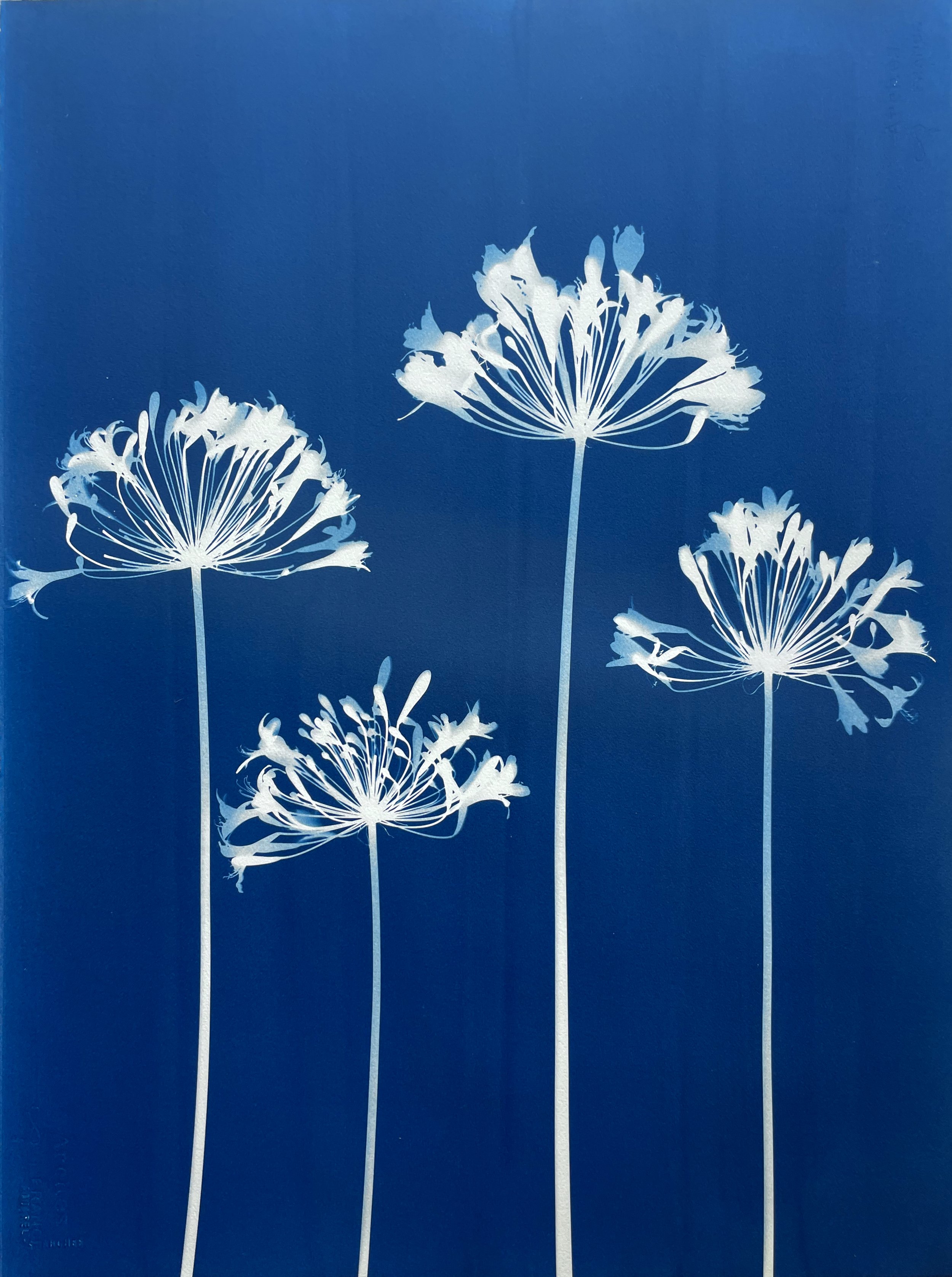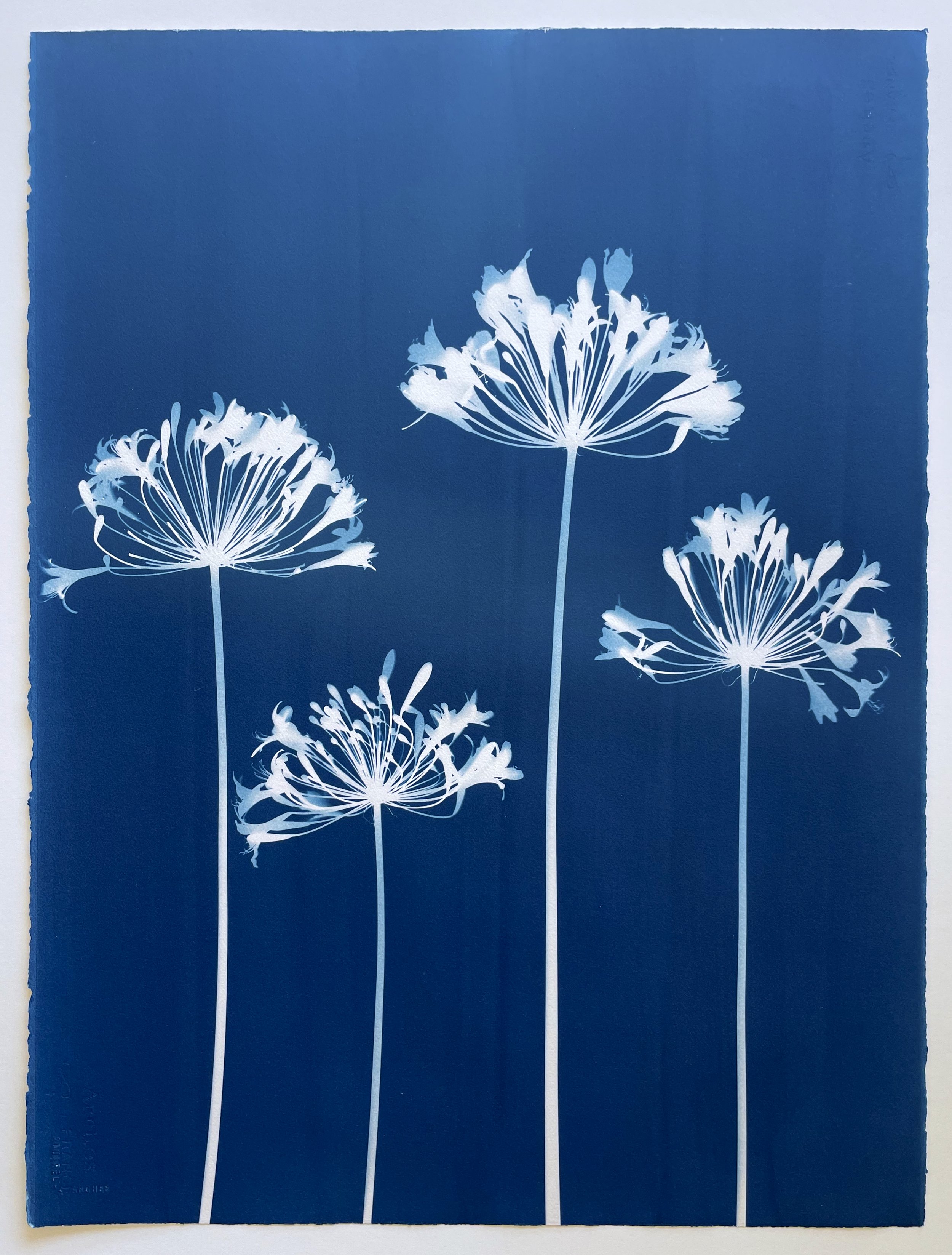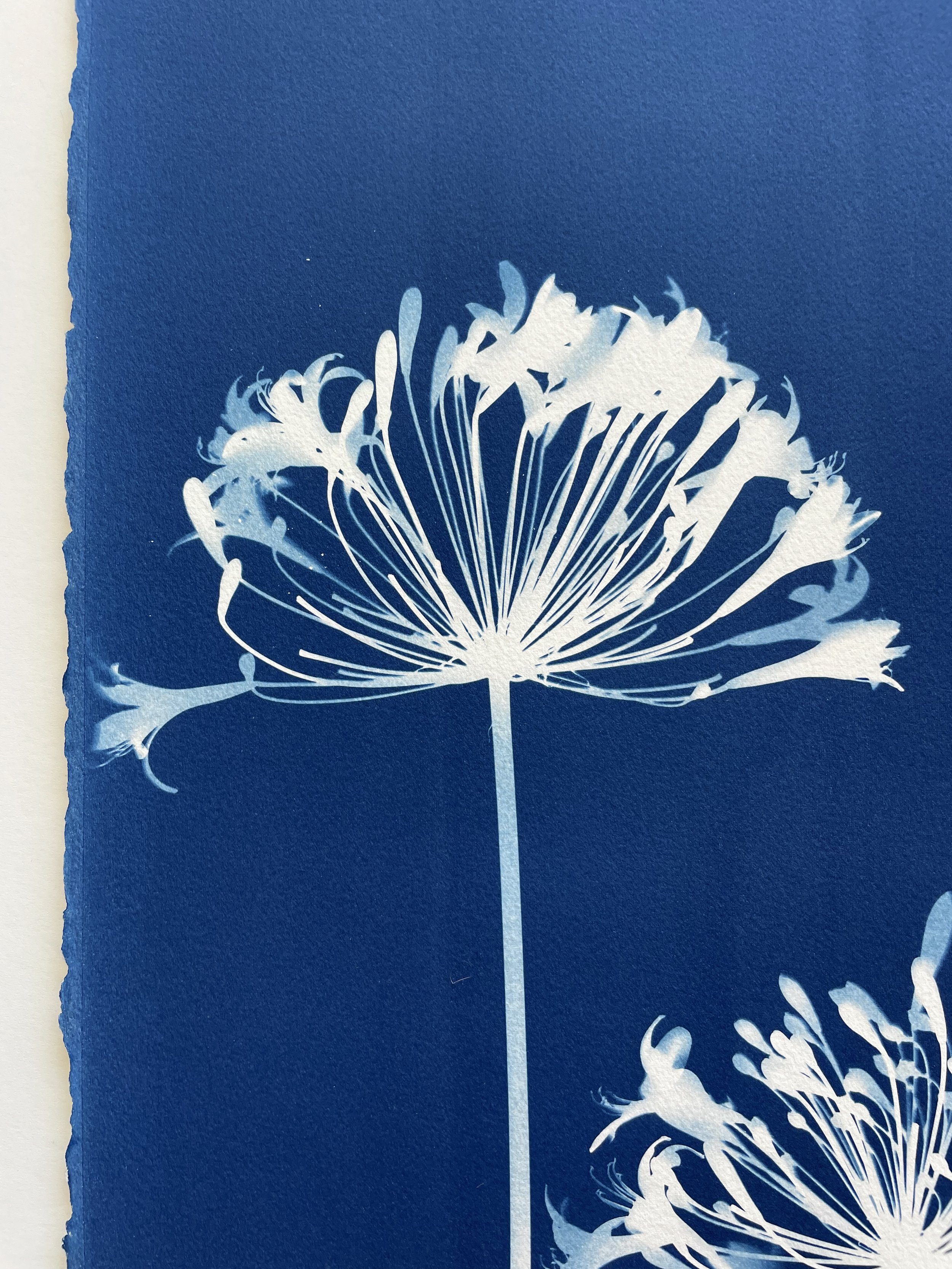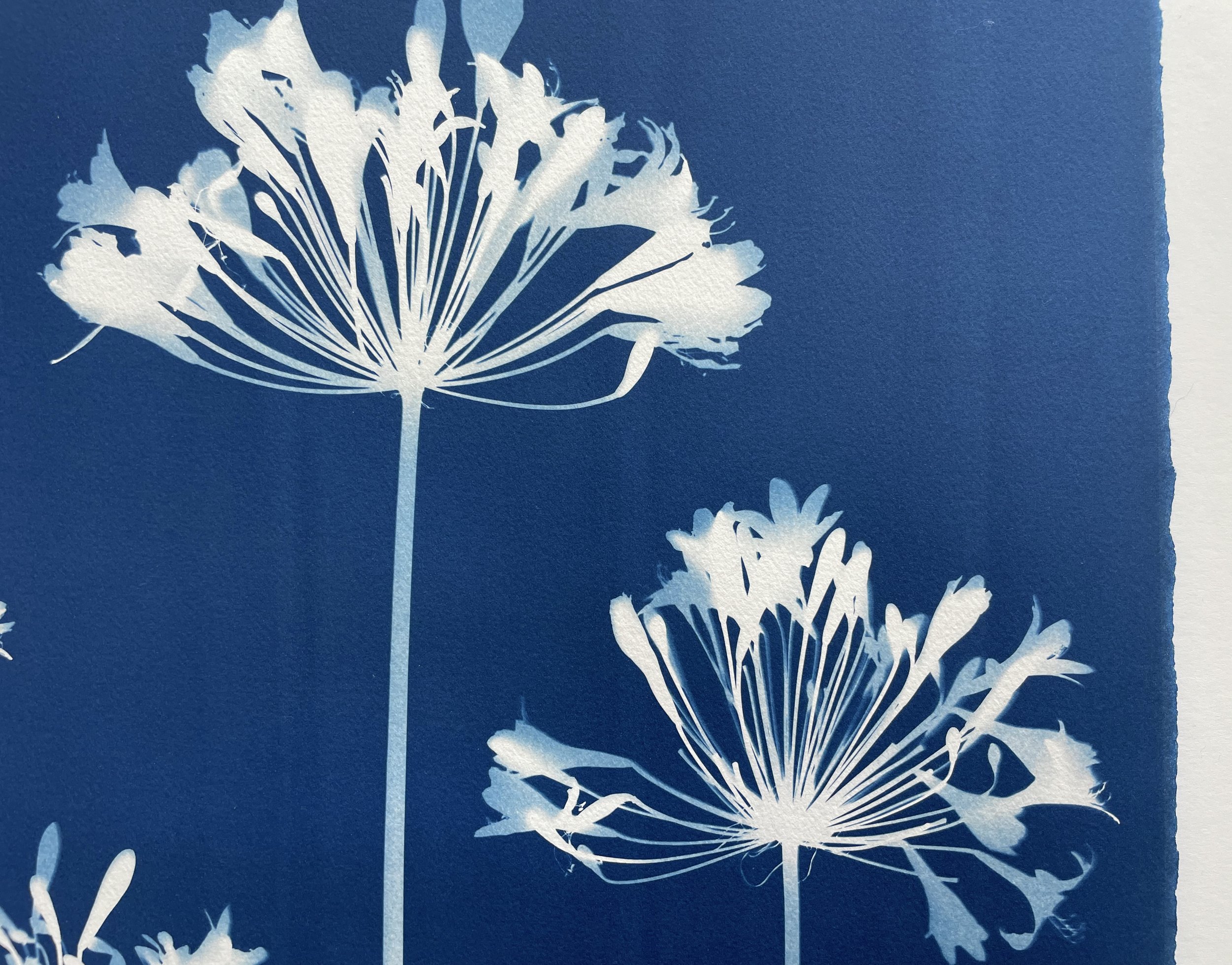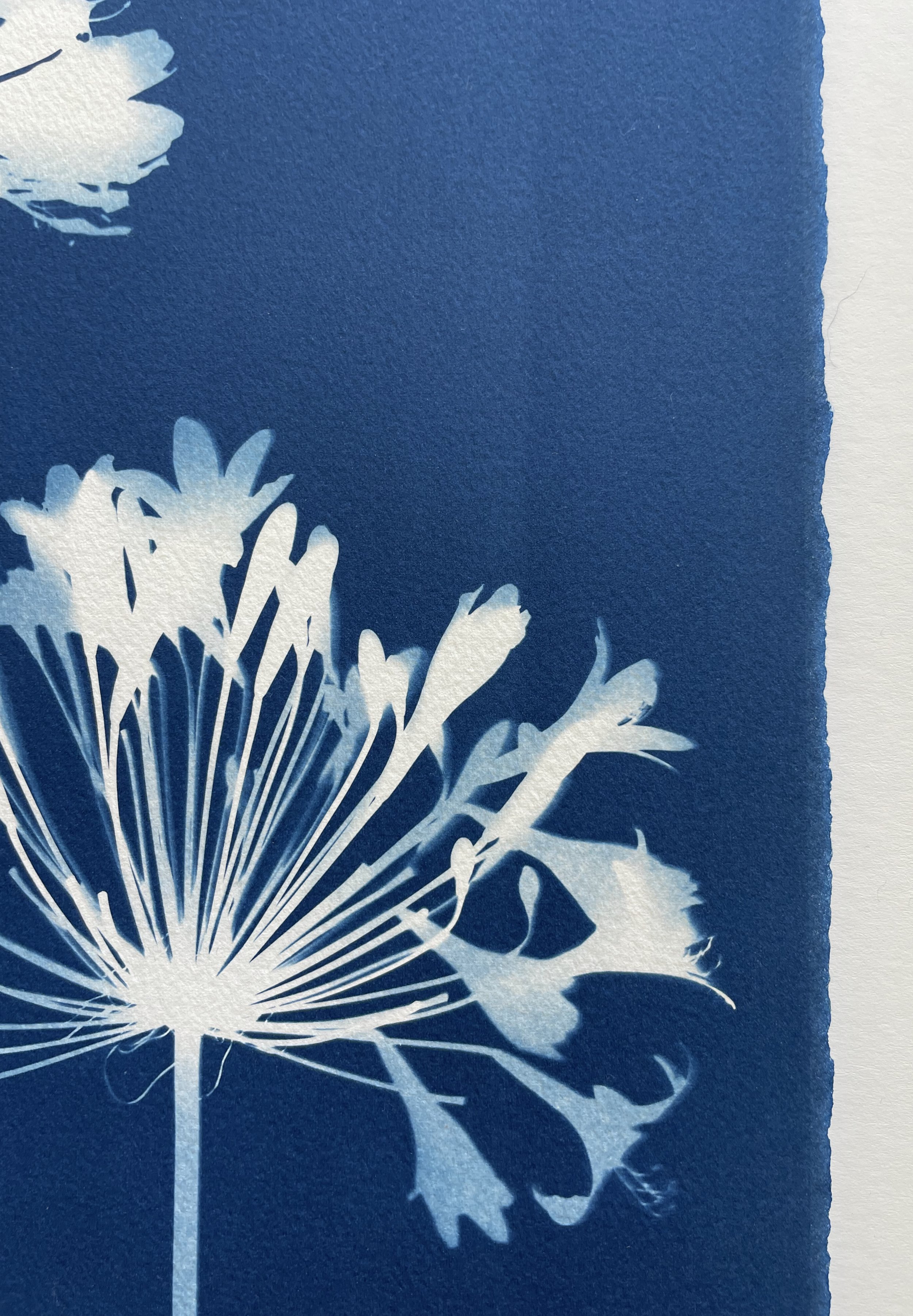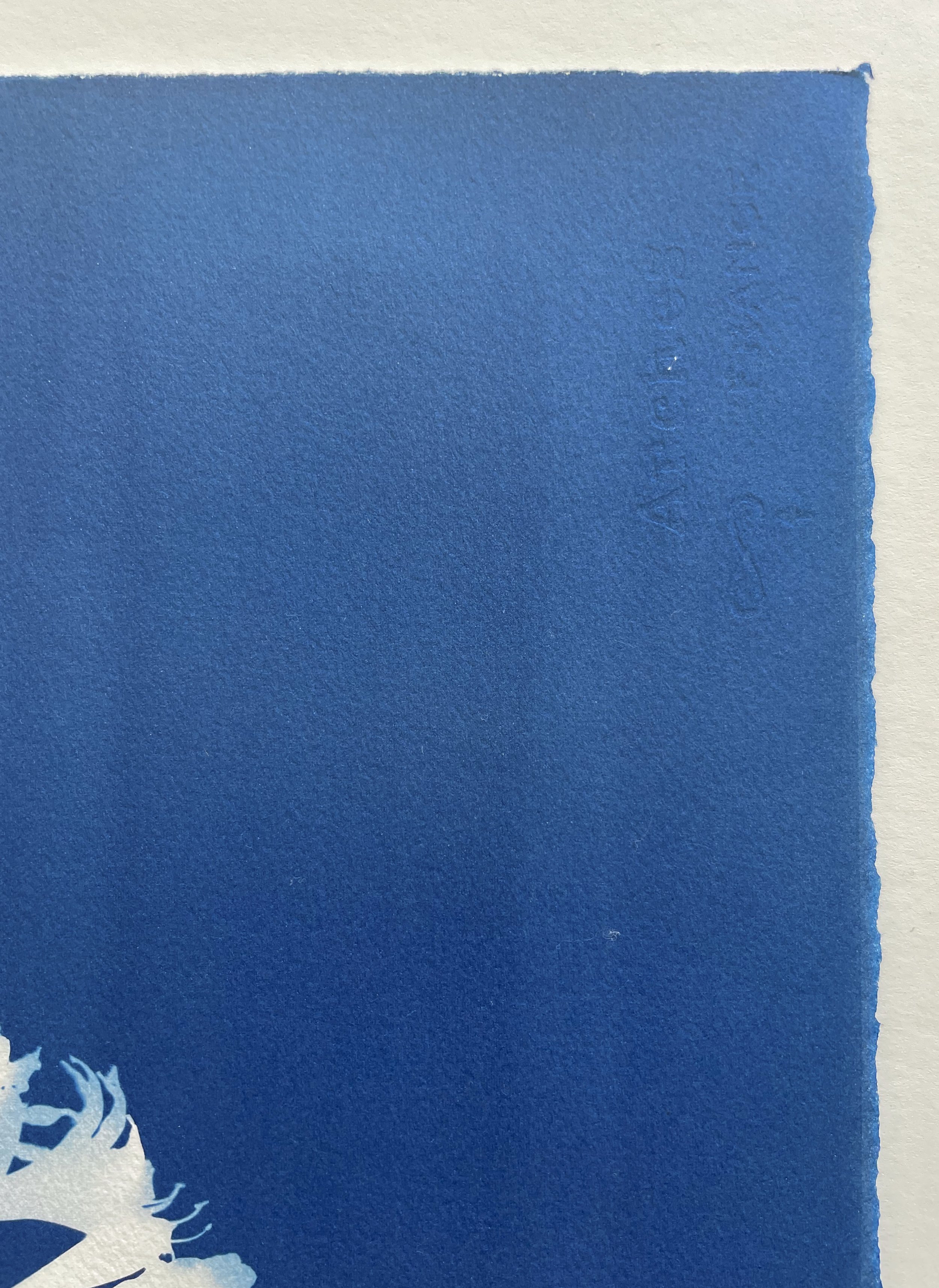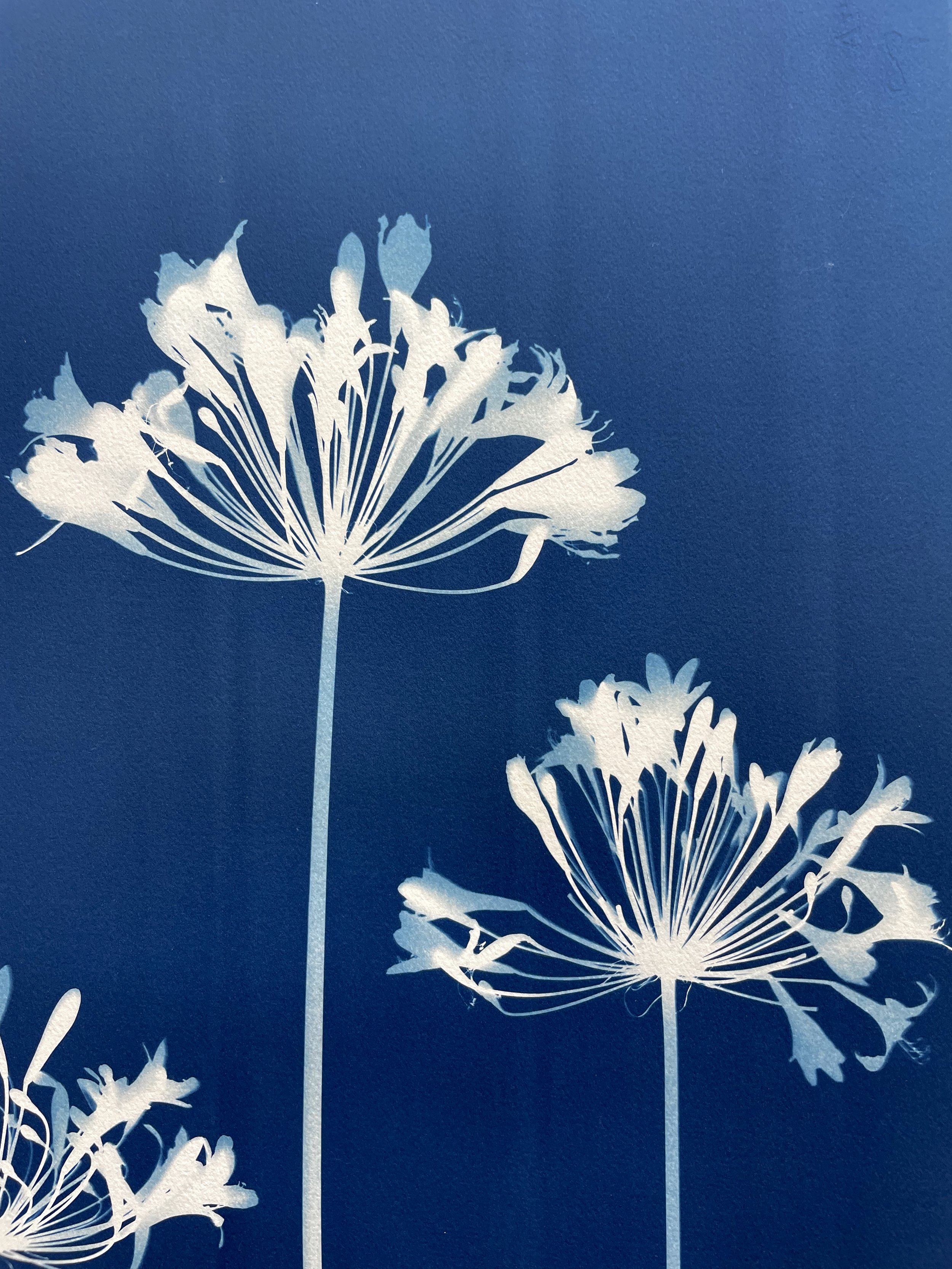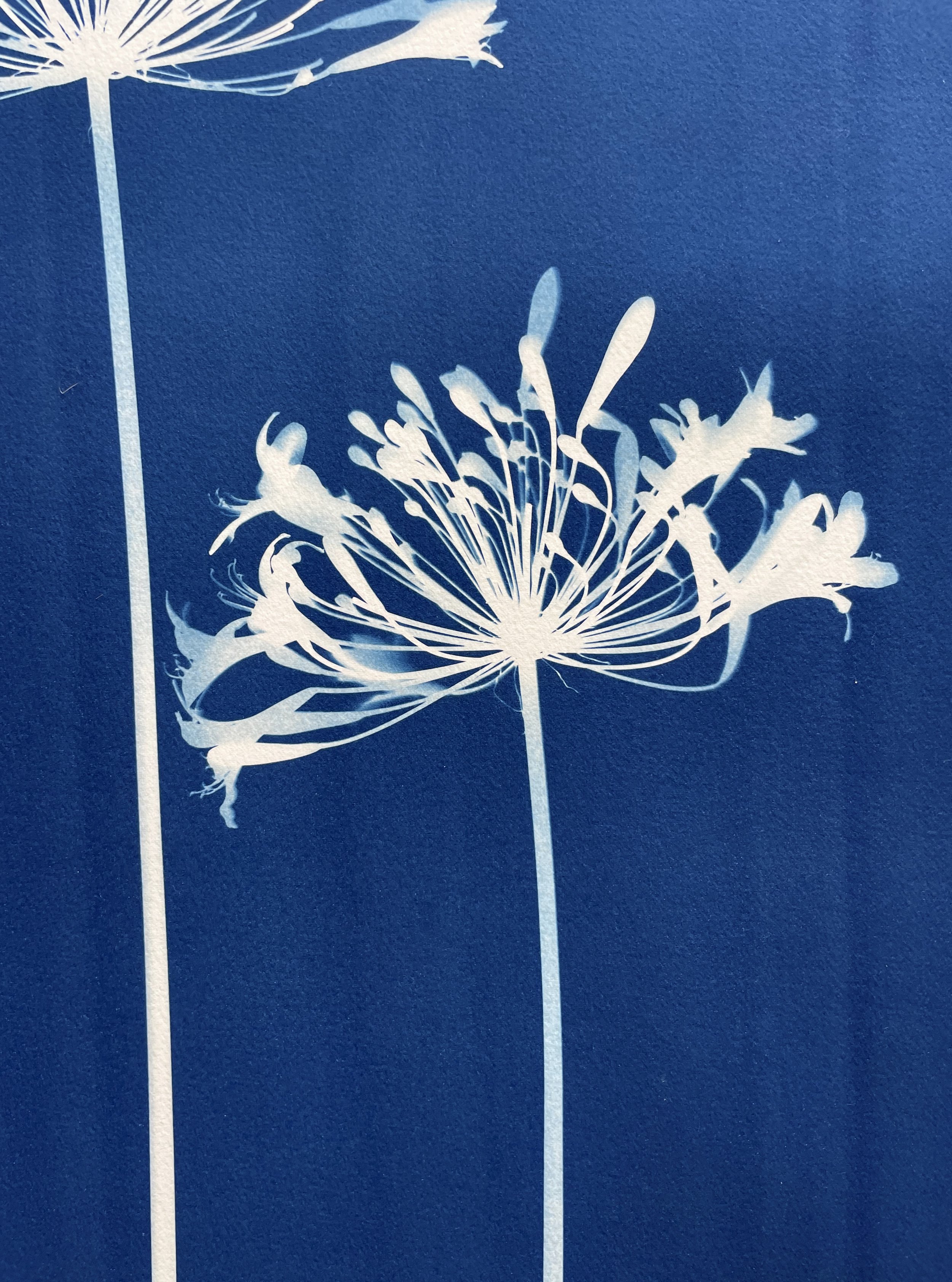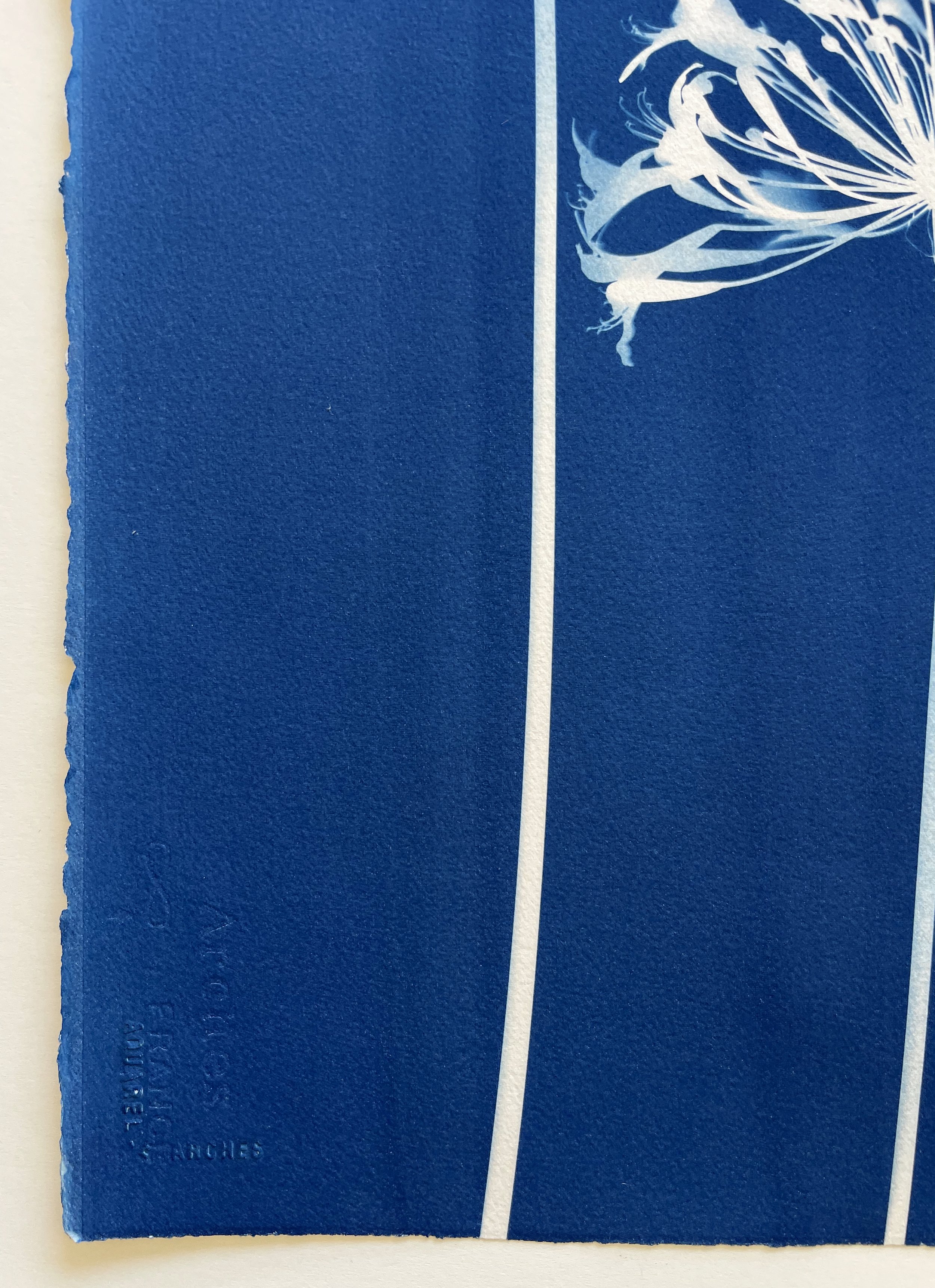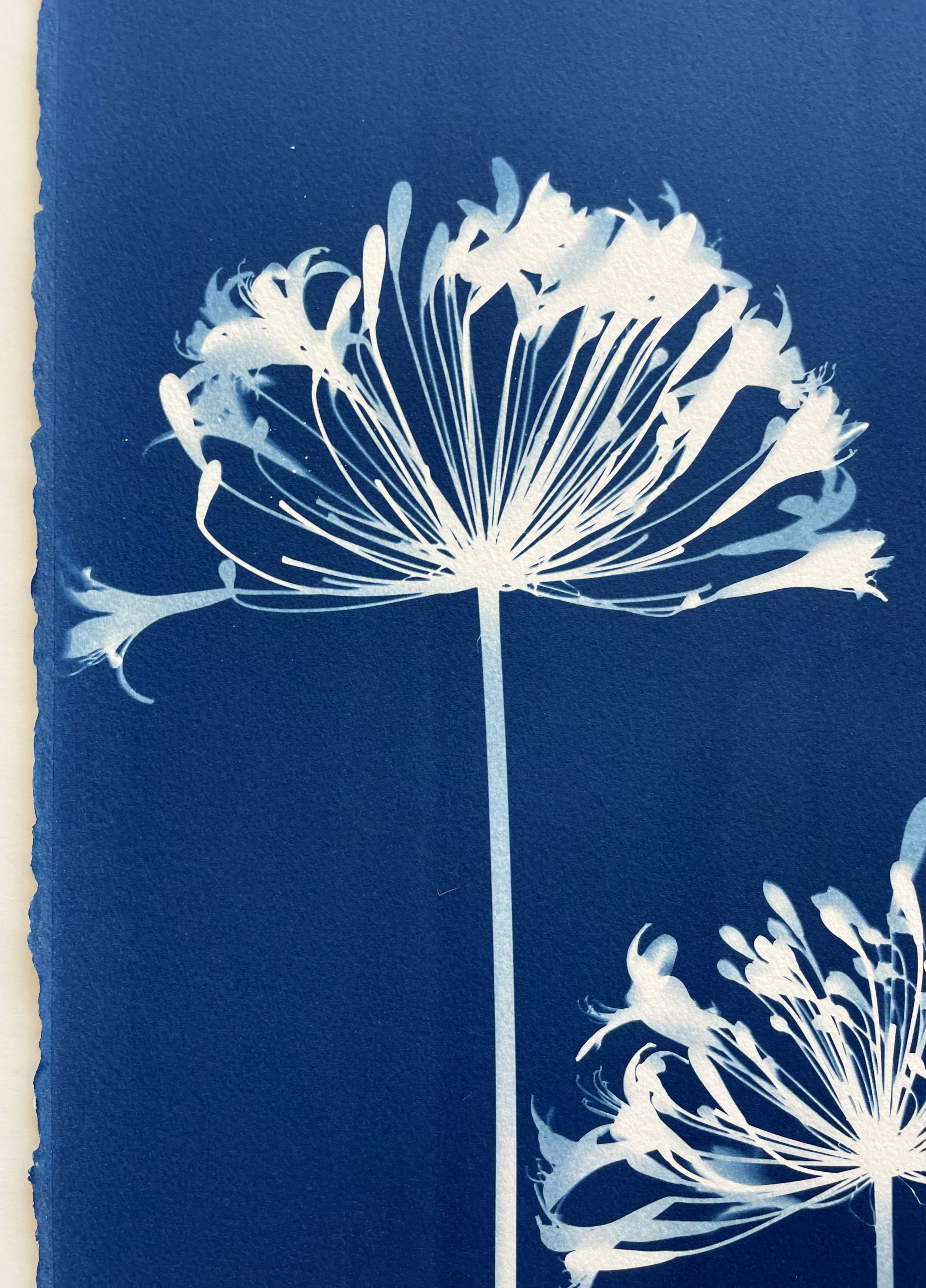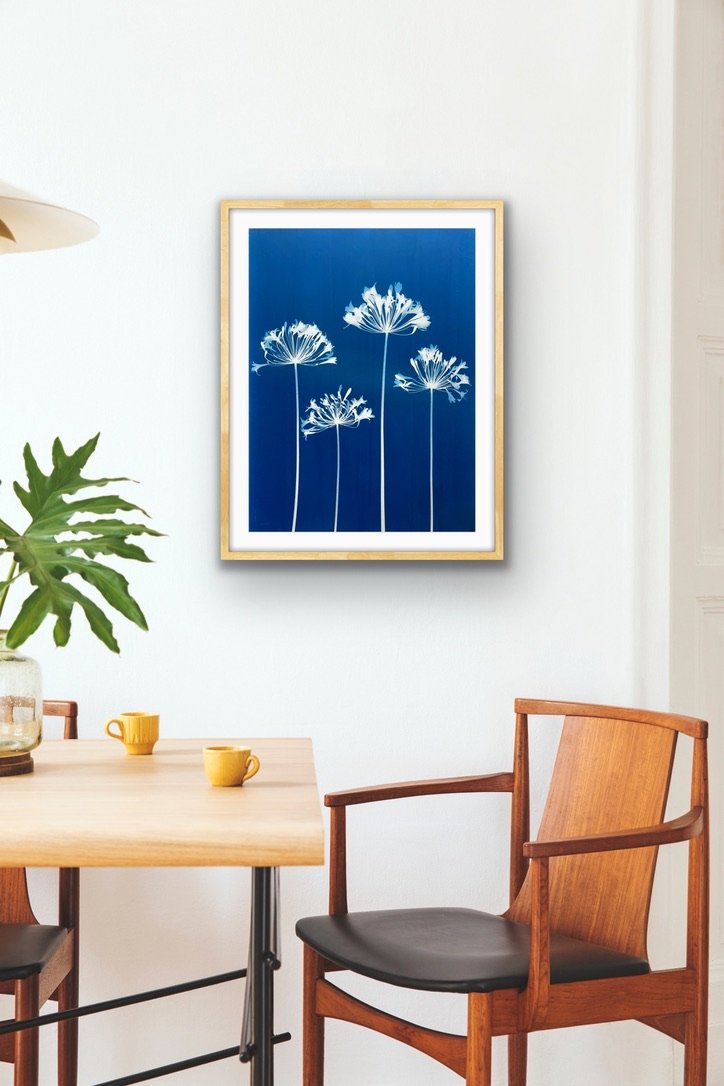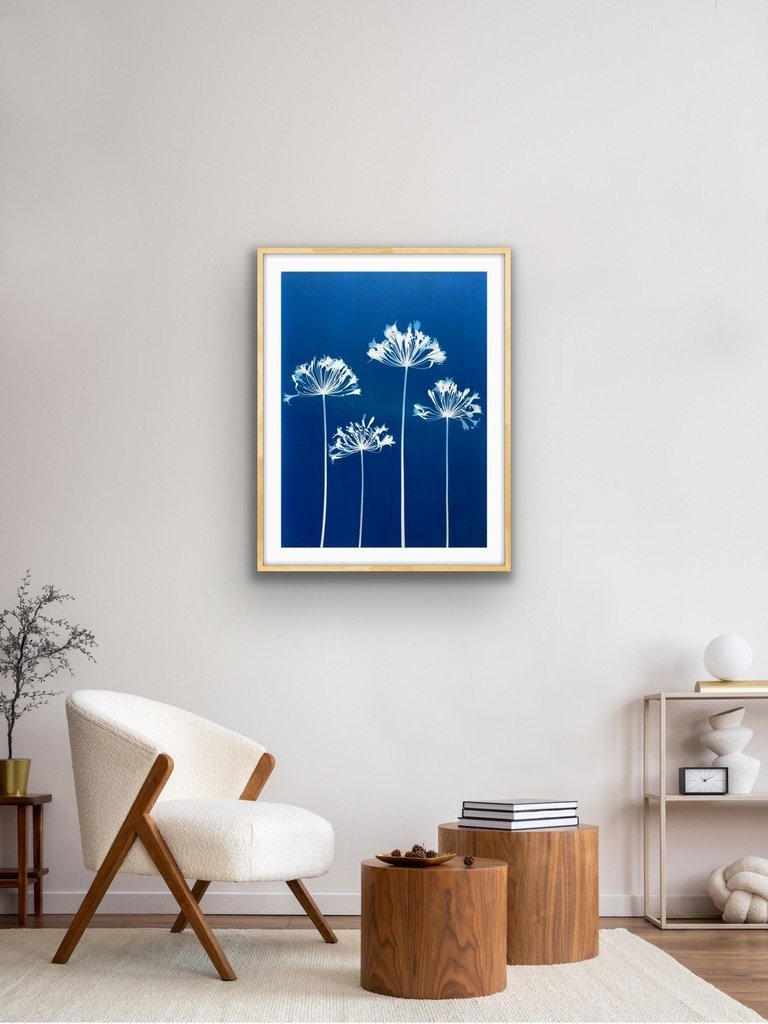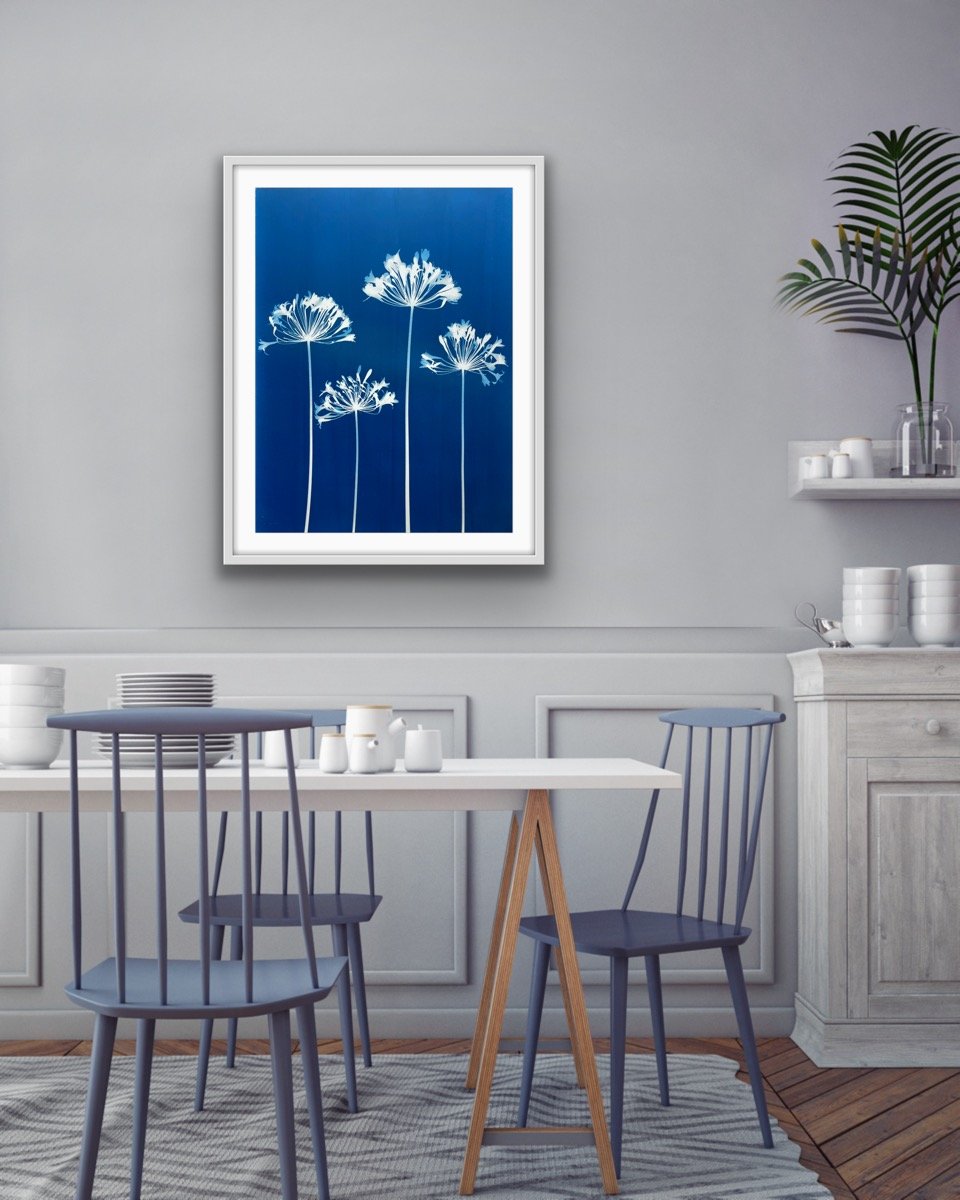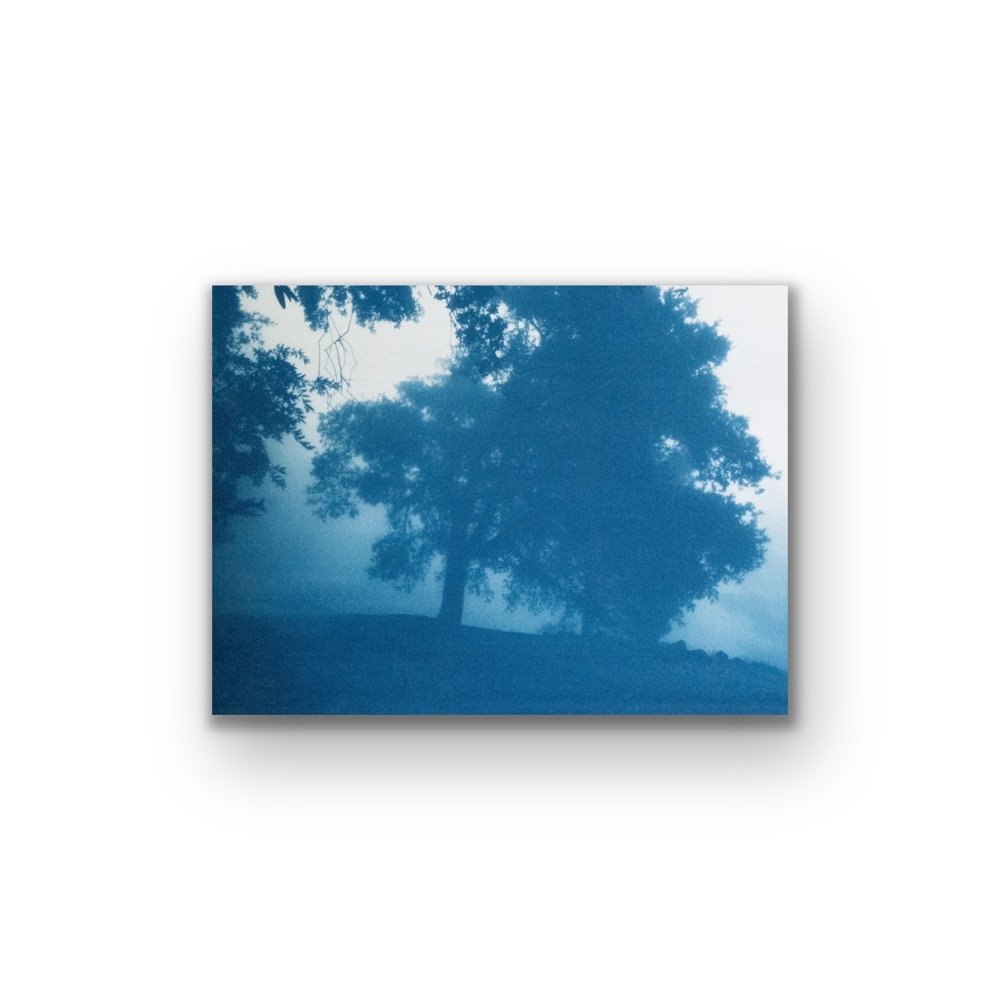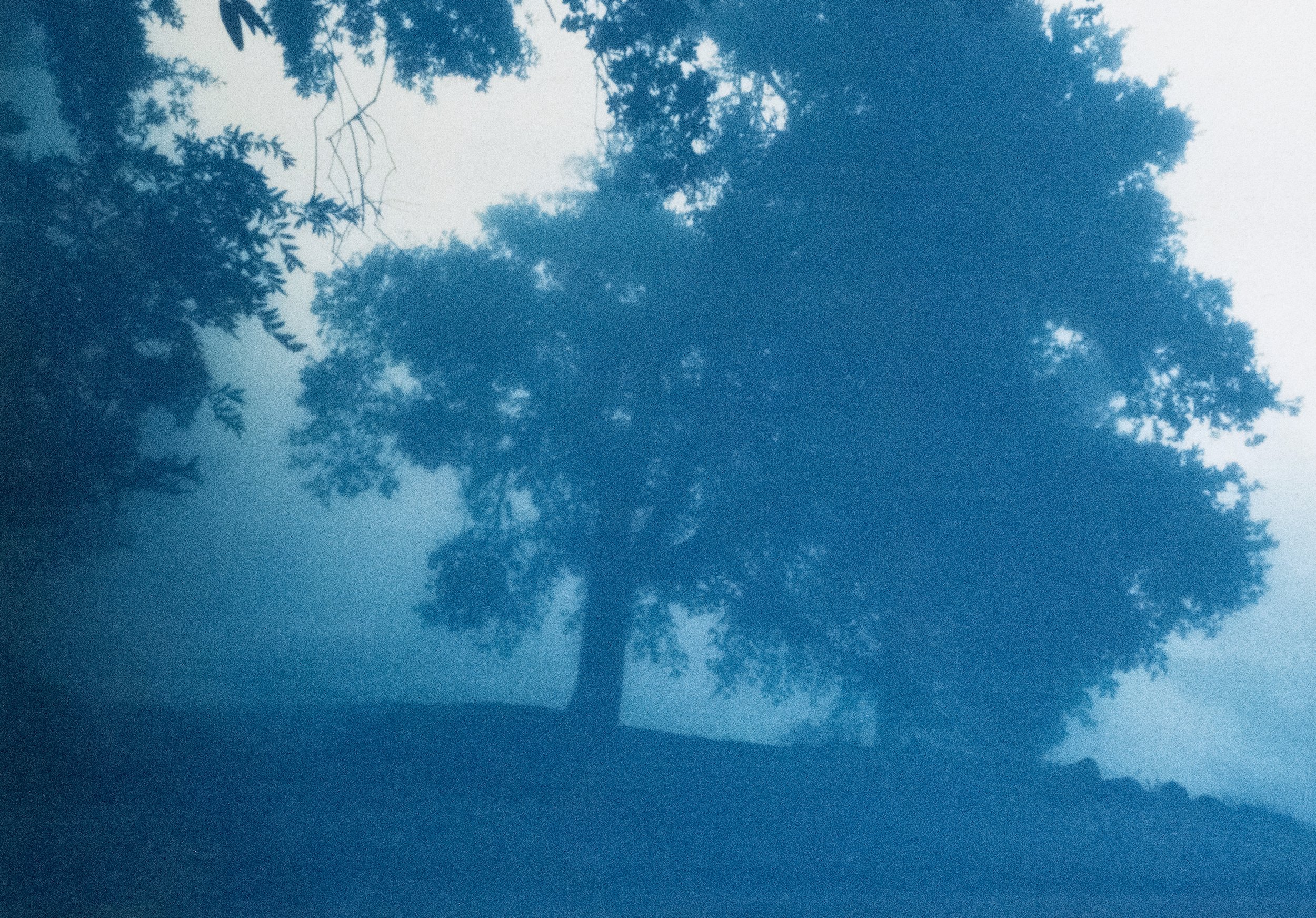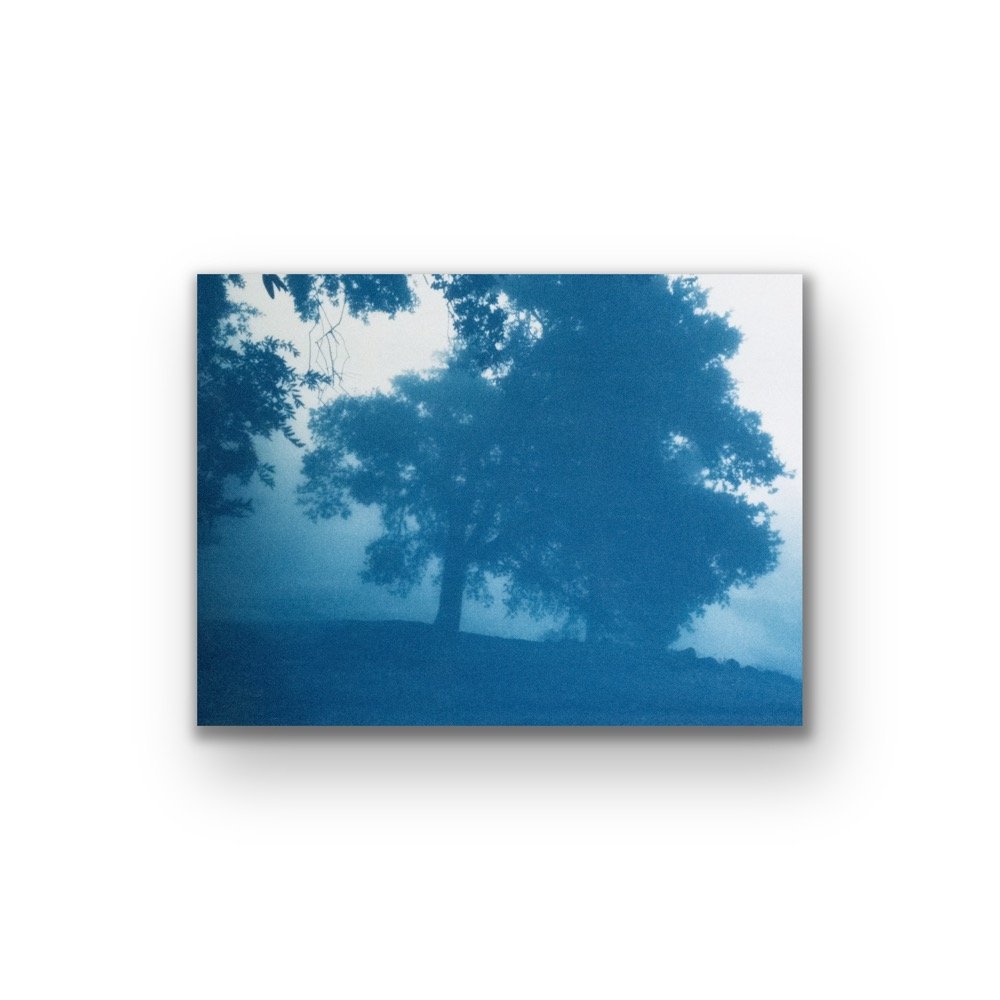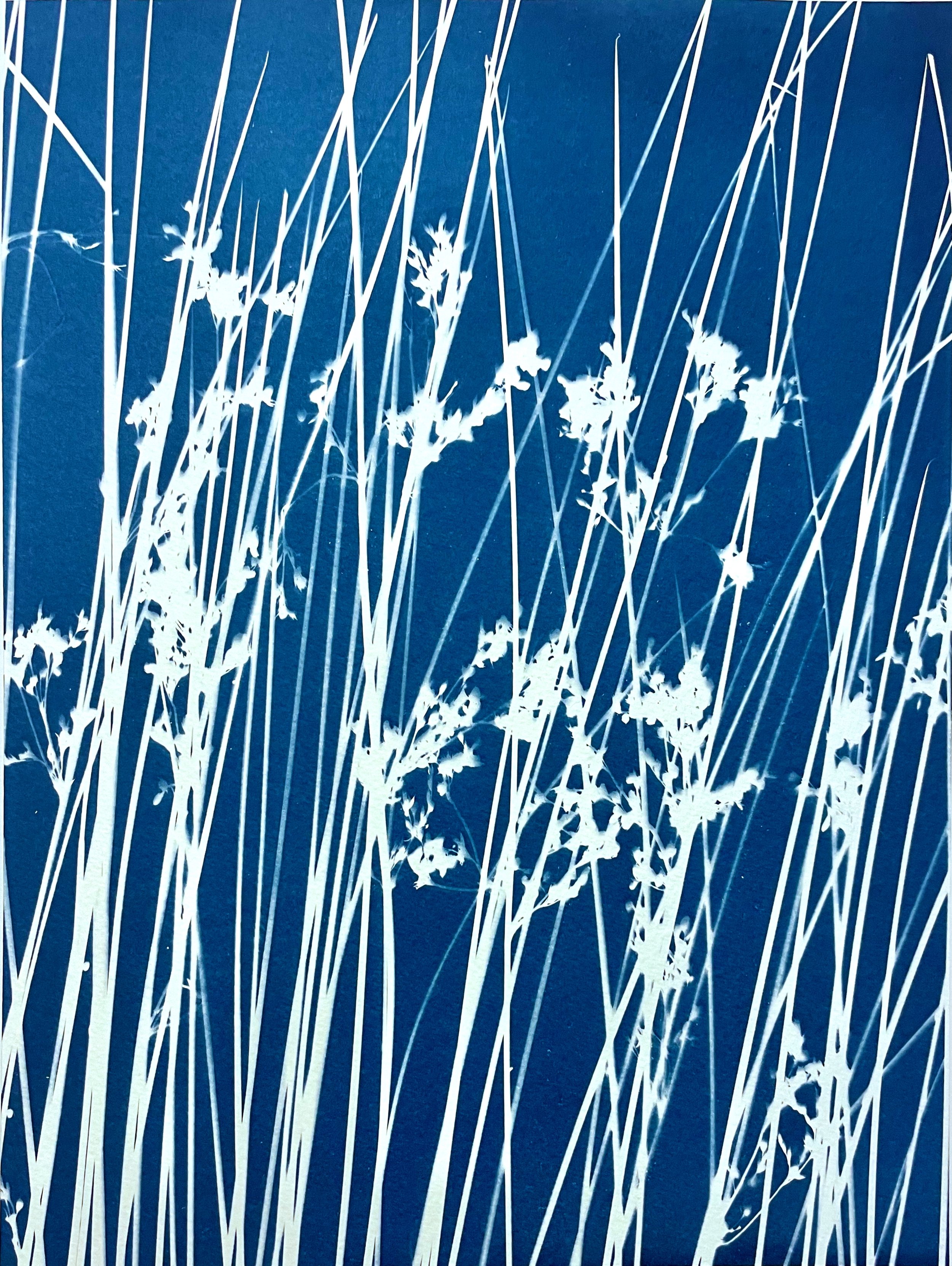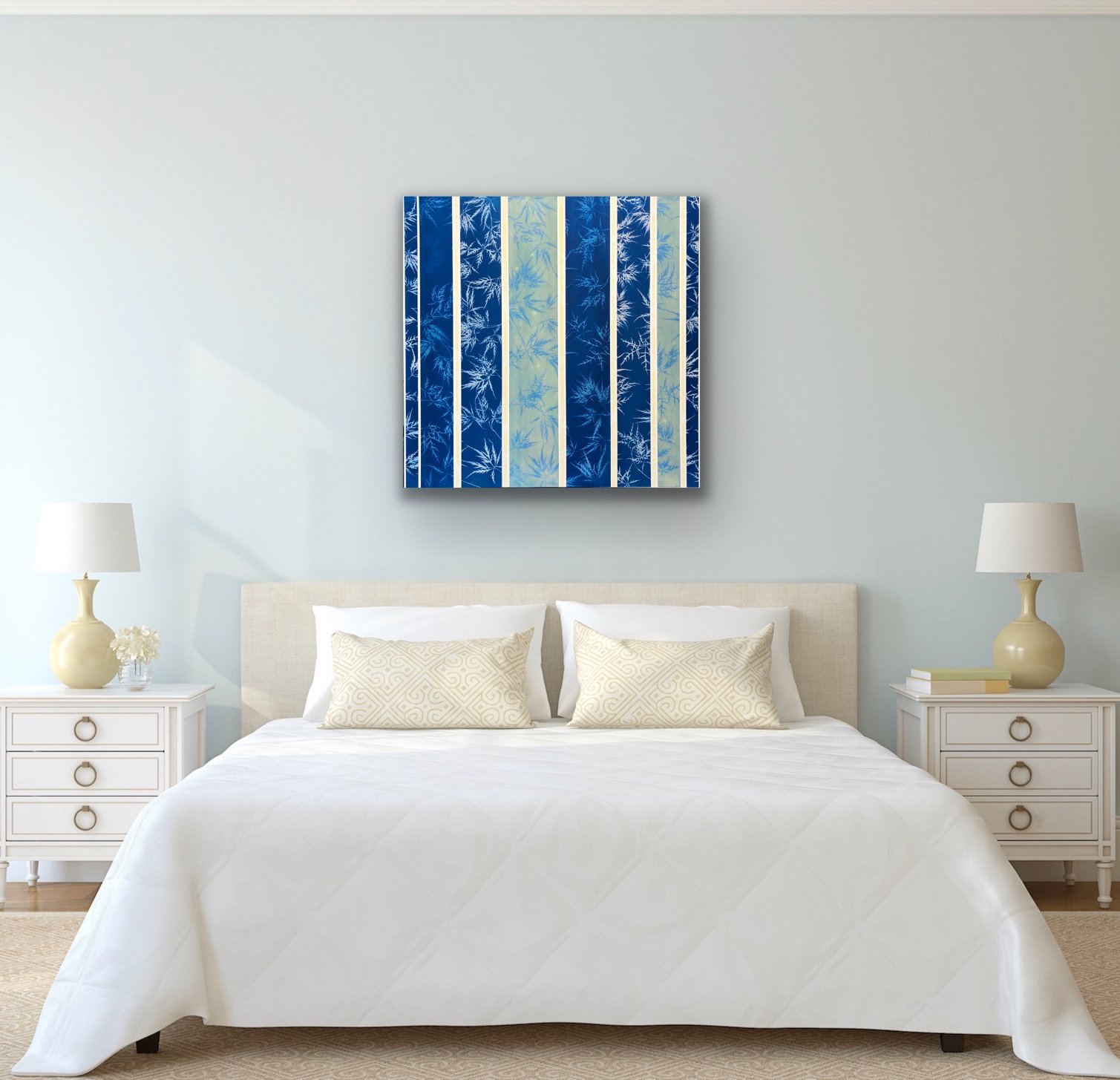 Image 1 of 8
Image 1 of 8

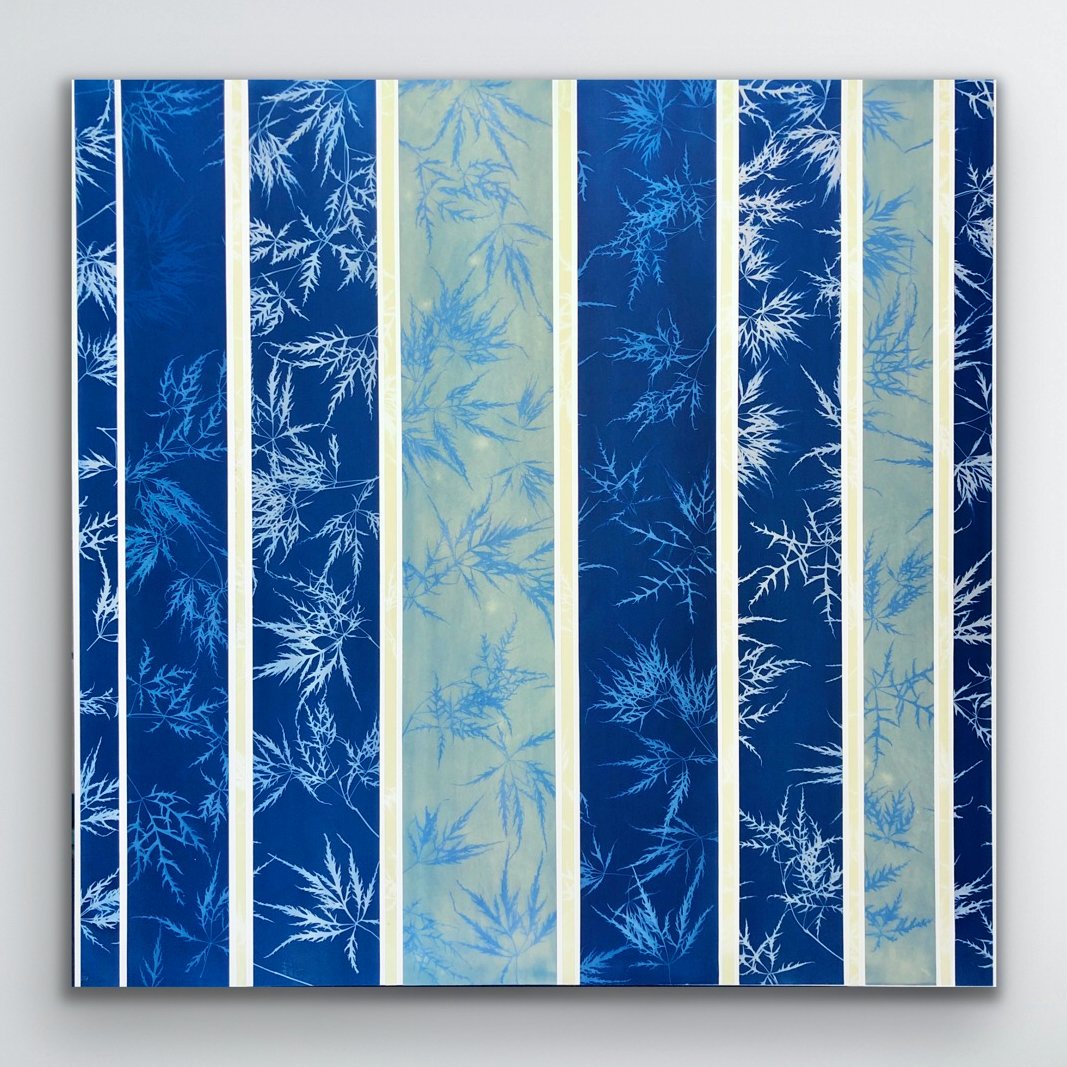 Image 2 of 8
Image 2 of 8

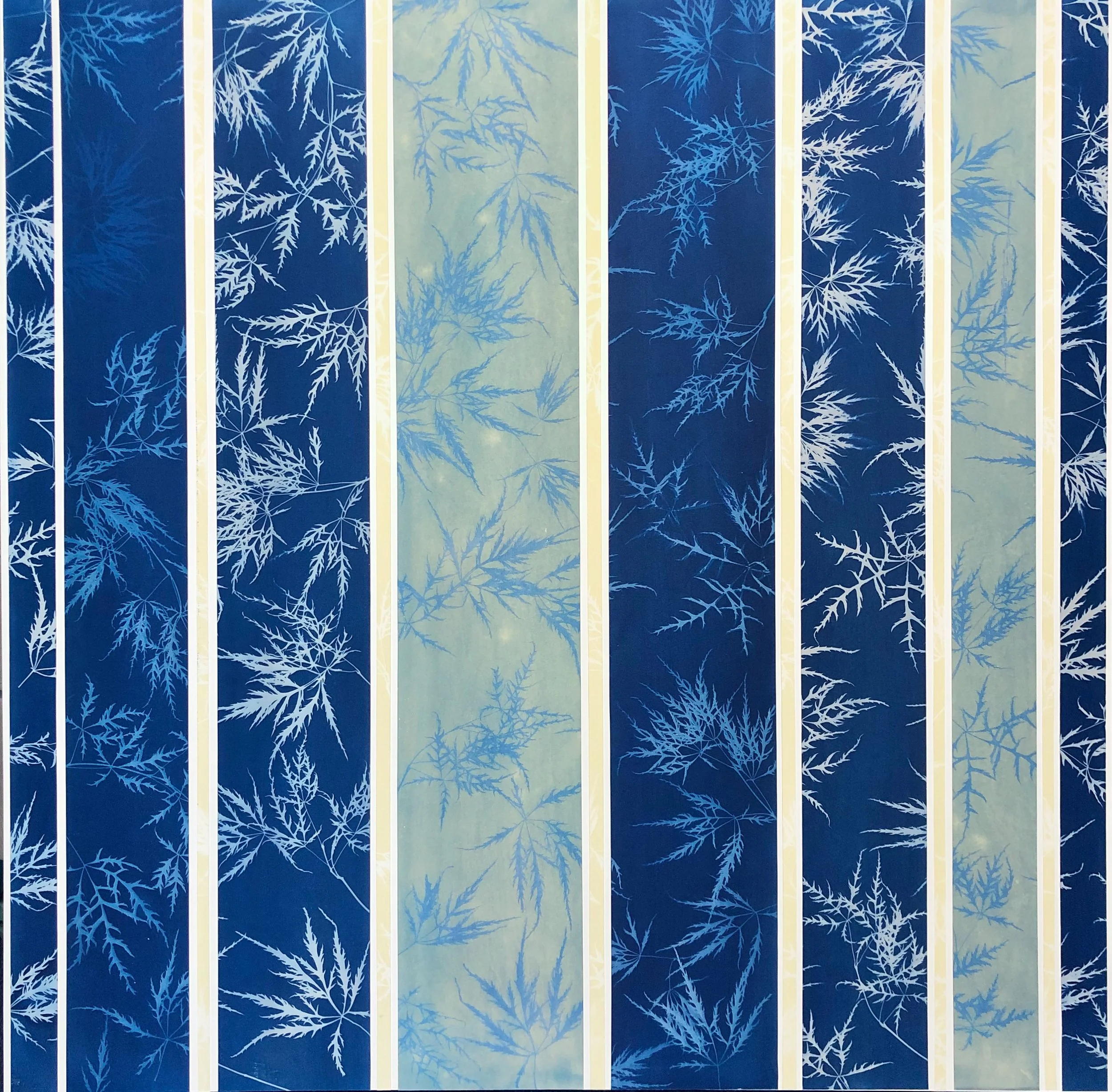 Image 3 of 8
Image 3 of 8

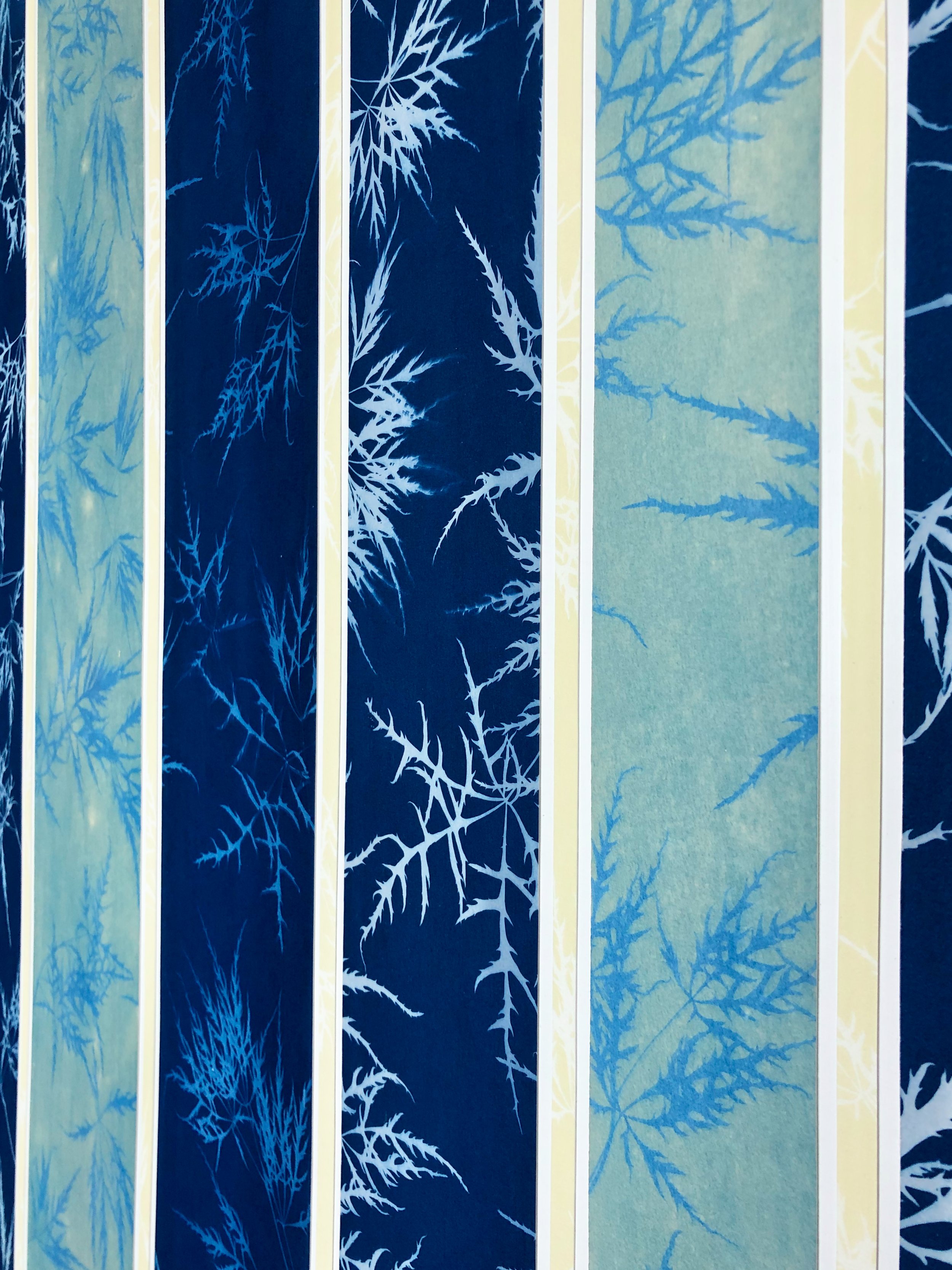 Image 4 of 8
Image 4 of 8

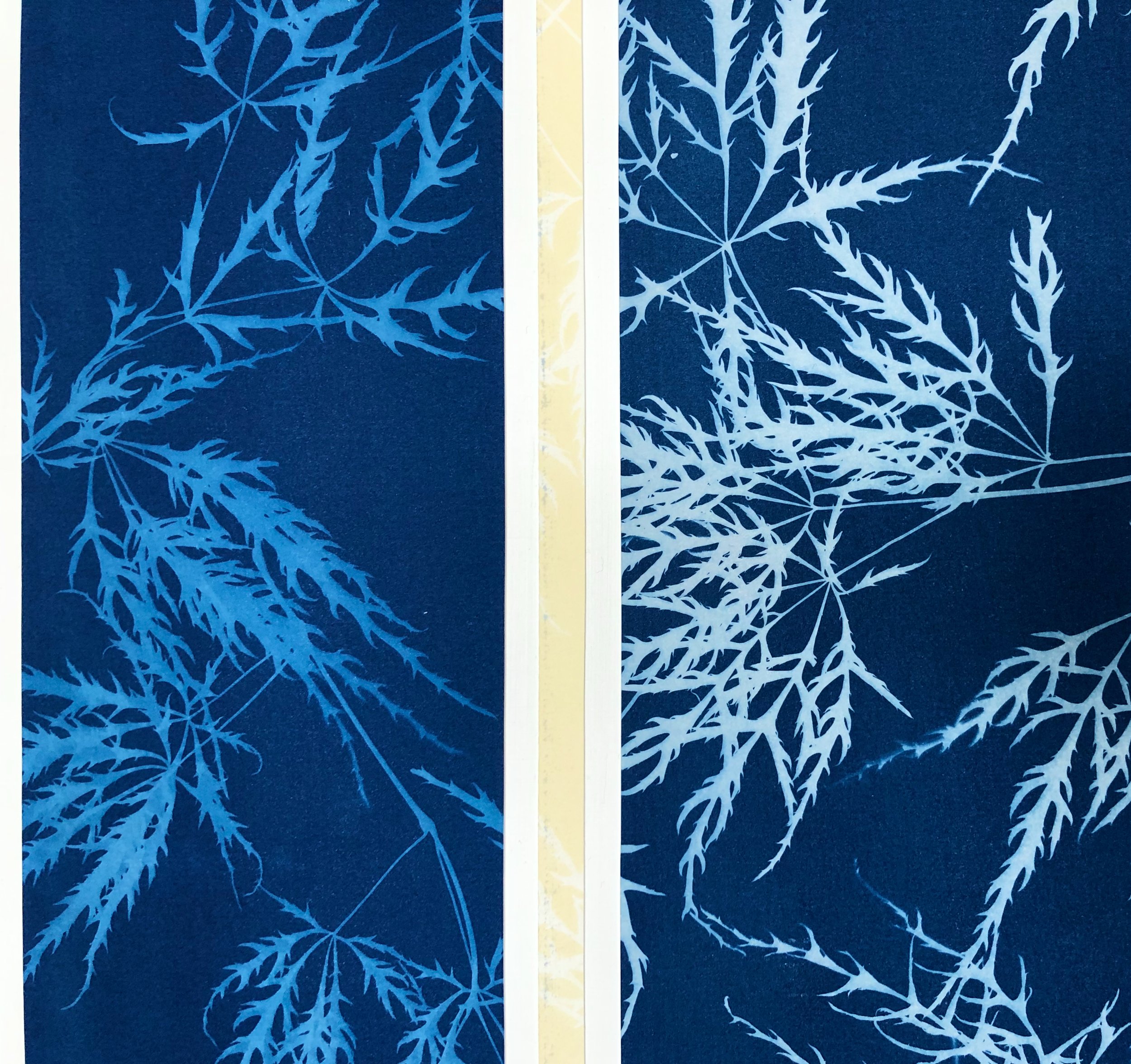 Image 5 of 8
Image 5 of 8

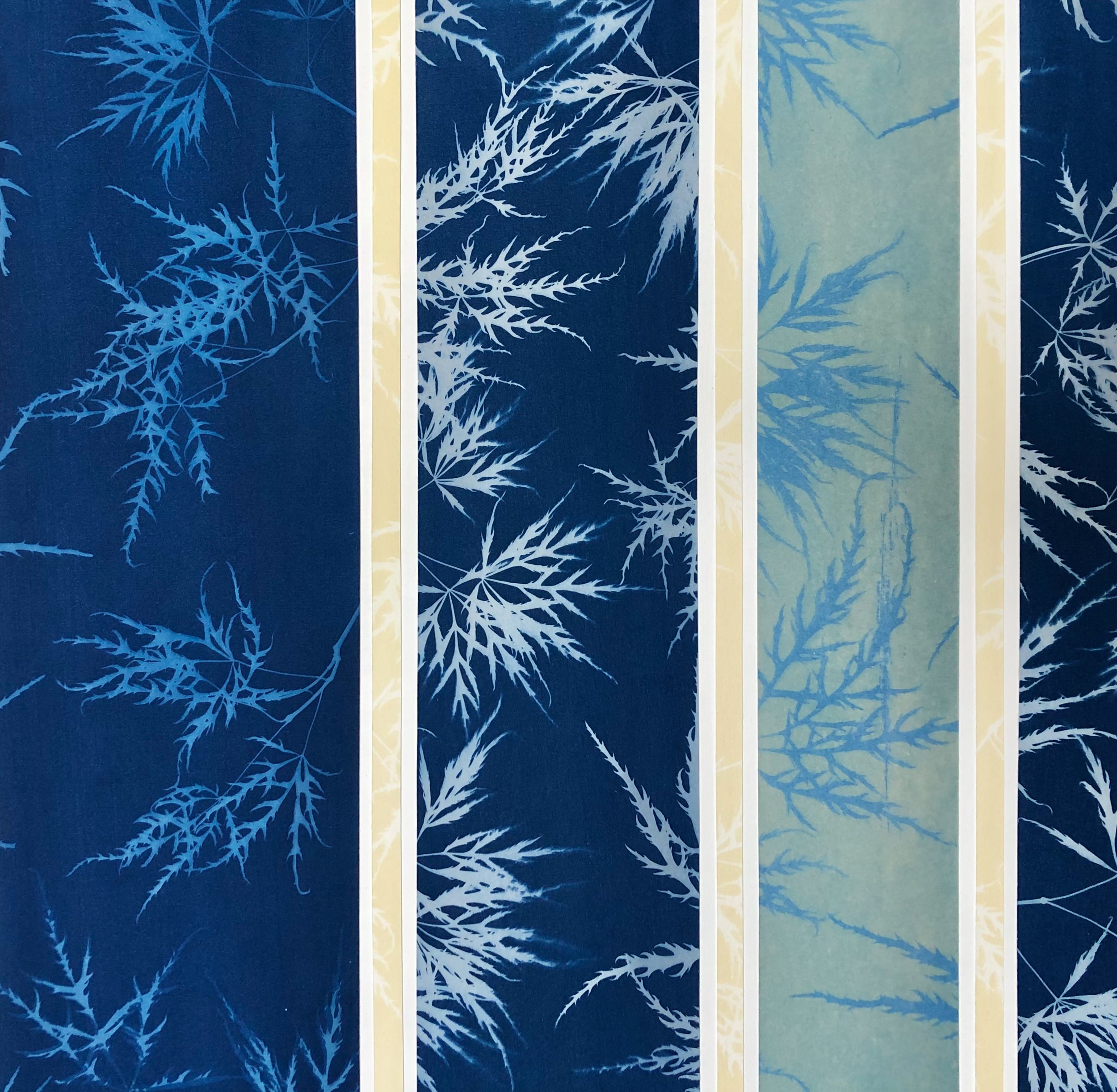 Image 6 of 8
Image 6 of 8

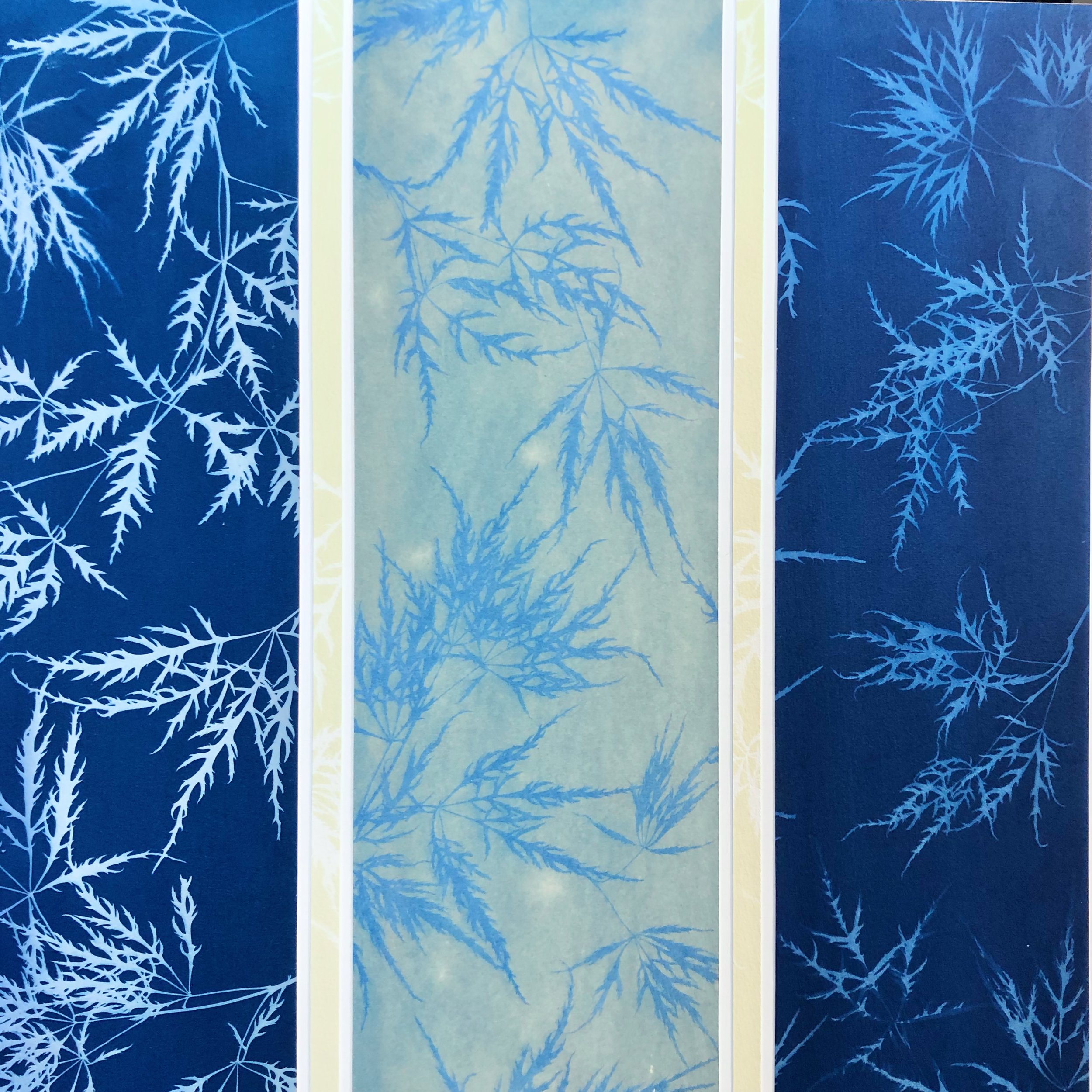 Image 7 of 8
Image 7 of 8

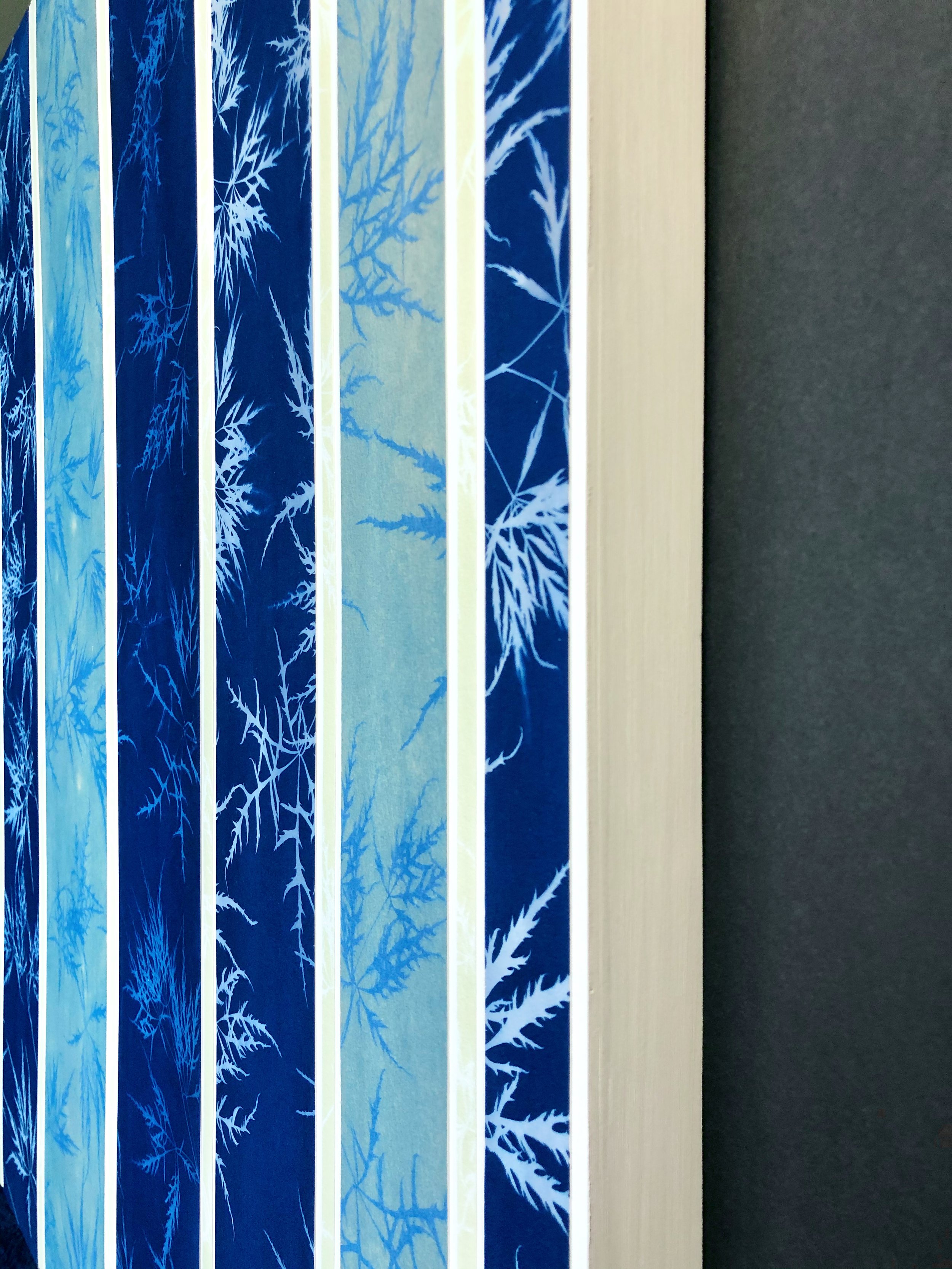 Image 8 of 8
Image 8 of 8









Into the Woods (36 x 36 x 1.5 inch collage of original cyanotypes on wood panel)
Each colored piece of paper was made was first hand-printed then cut up. Each color is an entirely unique hand-printed cyanotype. These are not etchings made from a reproducible image inscribed on a metal plate or carved in a block. My botanical cyanotypes made with living plants are all monotypes and technically a form of photography rather than printmaking as no ink is used, only photography chemicals.
Each strip of paper in this collage is a hand-printed cyanotype print made using plants in my own garden. I have four different Japanese maple trees. I chose the delicate leaves of the Acer disectum variety and printed papers repeatedly in different hues of the same blue by varying the seconds of exposure to light. The very narrow yellow strips were blue prints that I “toned” or turned lighter with detergent. The green strips of paper are a multilayered print of a blue layer over an already toned and dried yellow cyanotype print.
The fine white lines showing between all the colored strips are not paper but are rather the painted white wood panel that they are mounted upon which shows through. The white background has become an integral part of of the picture much in the way that the white in a watercolor painting comes about by simply leaving it bare rather than applying white paint.
The 1.5 inch deep sides of the wood panel are painted the same white which continues from the front to the sides and a sturdy hanging wire is attached to the back, making it ready to go on the wall without framing.
I used a quadruple-exposure blue print and a yellow toned cyanotype of the same species of leaves aligned in such a way that it looks like the branches continue across the color divide.
There is a 3/8 inch (1 1/4 cm) border of white painted wood showing around the image when viewed from the front and the four sides of the 1 1/2 inch (3 3/4 cm) deep birch cradled panel are painted white. This eliminates the need for a frame.
There is a wire on the back making it ready to hang immediately. The papers used in the collage are heavy 100% acid-free watercolor paper which will not yellow with age. The paper's surface is sealed with a transparent, matte layer of cold wax to protect it.
About “toning”: The yellow cyanotype print began as a blue cyanotype and was turned yellow through a process called "toning." After being printed and rinsed, a blue print was soaked in detergent to turn it a warm shade of butter yellow and then rinsed again and dried again.
The toning process adds two more days to the time it takes to make these prints and the toning itself has a high failure rate. There can be a small blue area that refuses to turn yellow, remaining a greyish mid-transformation color and spoiling the print. Because of this, the price is higher for my yellow cyanotypes than the normal blue. The thick watercolor paper is mounted on wooden panels with their 1.5 inch deep sides painted white as well as the front edge, which serves as a frame. Each panel individually measures 12 x 24 x 1.5 inches (30 x 60 x 4 cm). These two mounted prints on panels can be hung close together or spaced apart in a hallway or staircase.
The paper is sealed with a very thin coat of rubbed-on cold wax medium. This matte barely perceptible layer protects the paper against dirt, dust and moisture, but does not have the noticeable thick, shiny, glassy look of an encaustic finish.
CARE: It is recommended that you not hang this artwork in a bathroom or kitchen where there is a lot of moisture, but rather in a room with low humidity.
Each colored piece of paper was made was first hand-printed then cut up. Each color is an entirely unique hand-printed cyanotype. These are not etchings made from a reproducible image inscribed on a metal plate or carved in a block. My botanical cyanotypes made with living plants are all monotypes and technically a form of photography rather than printmaking as no ink is used, only photography chemicals.
Each strip of paper in this collage is a hand-printed cyanotype print made using plants in my own garden. I have four different Japanese maple trees. I chose the delicate leaves of the Acer disectum variety and printed papers repeatedly in different hues of the same blue by varying the seconds of exposure to light. The very narrow yellow strips were blue prints that I “toned” or turned lighter with detergent. The green strips of paper are a multilayered print of a blue layer over an already toned and dried yellow cyanotype print.
The fine white lines showing between all the colored strips are not paper but are rather the painted white wood panel that they are mounted upon which shows through. The white background has become an integral part of of the picture much in the way that the white in a watercolor painting comes about by simply leaving it bare rather than applying white paint.
The 1.5 inch deep sides of the wood panel are painted the same white which continues from the front to the sides and a sturdy hanging wire is attached to the back, making it ready to go on the wall without framing.
I used a quadruple-exposure blue print and a yellow toned cyanotype of the same species of leaves aligned in such a way that it looks like the branches continue across the color divide.
There is a 3/8 inch (1 1/4 cm) border of white painted wood showing around the image when viewed from the front and the four sides of the 1 1/2 inch (3 3/4 cm) deep birch cradled panel are painted white. This eliminates the need for a frame.
There is a wire on the back making it ready to hang immediately. The papers used in the collage are heavy 100% acid-free watercolor paper which will not yellow with age. The paper's surface is sealed with a transparent, matte layer of cold wax to protect it.
About “toning”: The yellow cyanotype print began as a blue cyanotype and was turned yellow through a process called "toning." After being printed and rinsed, a blue print was soaked in detergent to turn it a warm shade of butter yellow and then rinsed again and dried again.
The toning process adds two more days to the time it takes to make these prints and the toning itself has a high failure rate. There can be a small blue area that refuses to turn yellow, remaining a greyish mid-transformation color and spoiling the print. Because of this, the price is higher for my yellow cyanotypes than the normal blue. The thick watercolor paper is mounted on wooden panels with their 1.5 inch deep sides painted white as well as the front edge, which serves as a frame. Each panel individually measures 12 x 24 x 1.5 inches (30 x 60 x 4 cm). These two mounted prints on panels can be hung close together or spaced apart in a hallway or staircase.
The paper is sealed with a very thin coat of rubbed-on cold wax medium. This matte barely perceptible layer protects the paper against dirt, dust and moisture, but does not have the noticeable thick, shiny, glassy look of an encaustic finish.
CARE: It is recommended that you not hang this artwork in a bathroom or kitchen where there is a lot of moisture, but rather in a room with low humidity.
Each colored piece of paper was made was first hand-printed then cut up. Each color is an entirely unique hand-printed cyanotype. These are not etchings made from a reproducible image inscribed on a metal plate or carved in a block. My botanical cyanotypes made with living plants are all monotypes and technically a form of photography rather than printmaking as no ink is used, only photography chemicals.
Each strip of paper in this collage is a hand-printed cyanotype print made using plants in my own garden. I have four different Japanese maple trees. I chose the delicate leaves of the Acer disectum variety and printed papers repeatedly in different hues of the same blue by varying the seconds of exposure to light. The very narrow yellow strips were blue prints that I “toned” or turned lighter with detergent. The green strips of paper are a multilayered print of a blue layer over an already toned and dried yellow cyanotype print.
The fine white lines showing between all the colored strips are not paper but are rather the painted white wood panel that they are mounted upon which shows through. The white background has become an integral part of of the picture much in the way that the white in a watercolor painting comes about by simply leaving it bare rather than applying white paint.
The 1.5 inch deep sides of the wood panel are painted the same white which continues from the front to the sides and a sturdy hanging wire is attached to the back, making it ready to go on the wall without framing.
I used a quadruple-exposure blue print and a yellow toned cyanotype of the same species of leaves aligned in such a way that it looks like the branches continue across the color divide.
There is a 3/8 inch (1 1/4 cm) border of white painted wood showing around the image when viewed from the front and the four sides of the 1 1/2 inch (3 3/4 cm) deep birch cradled panel are painted white. This eliminates the need for a frame.
There is a wire on the back making it ready to hang immediately. The papers used in the collage are heavy 100% acid-free watercolor paper which will not yellow with age. The paper's surface is sealed with a transparent, matte layer of cold wax to protect it.
About “toning”: The yellow cyanotype print began as a blue cyanotype and was turned yellow through a process called "toning." After being printed and rinsed, a blue print was soaked in detergent to turn it a warm shade of butter yellow and then rinsed again and dried again.
The toning process adds two more days to the time it takes to make these prints and the toning itself has a high failure rate. There can be a small blue area that refuses to turn yellow, remaining a greyish mid-transformation color and spoiling the print. Because of this, the price is higher for my yellow cyanotypes than the normal blue. The thick watercolor paper is mounted on wooden panels with their 1.5 inch deep sides painted white as well as the front edge, which serves as a frame. Each panel individually measures 12 x 24 x 1.5 inches (30 x 60 x 4 cm). These two mounted prints on panels can be hung close together or spaced apart in a hallway or staircase.
The paper is sealed with a very thin coat of rubbed-on cold wax medium. This matte barely perceptible layer protects the paper against dirt, dust and moisture, but does not have the noticeable thick, shiny, glassy look of an encaustic finish.
CARE: It is recommended that you not hang this artwork in a bathroom or kitchen where there is a lot of moisture, but rather in a room with low humidity.
You Might Also Like

